- Jennifer Holbus
- Oct 23, 2023
- 10 min read

DMAIC - The 5 Phases of Lean Six Sigma
What is DMAIC?
DMAIC stands for Define, Measure, Analyze, Improve, and Control. It is a structured problem-solving methodology commonly used in Six Sigma and process improvement initiatives. DMAIC provides a systematic approach for identifying and addressing problems, improving processes, and achieving measurable results.
Why use the DMAIC process?
DMAIC provides a structured and systematic approach to problem-solving and process improvement. It offers a clear roadmap with defined steps, ensuring that the improvement efforts are focused and organized.
DMAIC emphasizes the collection and analysis of data to understand the current state of the process and identify the root causes of problems. By relying on data, organizations can make informed decisions rather than relying on subjective opinions or assumptions.
The Analyze phase of DMAIC focuses on identifying the root causes of process issues. By understanding the underlying factors contributing to problems, organizations can implement effective and targeted solutions rather than simply addressing symptoms.
DMAIC encourages the use of key performance indicators (KPIs) and measurement systems to assess process performance. This focus on measurement allows organizations to track improvements over time, quantify the impact of changes, and ensure that the desired outcomes are achieved.
DMAIC promotes a culture of continuous improvement within an organization. By following the DMAIC process, organizations can identify opportunities for improvement, implement changes, and then monitor and control the process to sustain the improvements achieved. It establishes a cycle of continuous learning and refinement.
DMAIC provides a standardized framework that can be applied consistently across different projects and teams. This ensures that best practices are followed, knowledge is shared, and lessons learned from one project can be applied to future initiatives.
DMAIC emphasizes the importance of understanding customer requirements and expectations. By defining and measuring customer needs, organizations can align their improvement efforts to deliver products or services that meet or exceed customer expectations.
What’s the difference between Six Sigma and DMAIC?
In essence, Six Sigma is a broader concept that encompasses various principles, tools, and techniques for quality improvement. The DMAIC methodology is a specific process used within Six Sigma projects to guide teams through the problem-solving process. DMAIC is one of the most commonly used methodologies in Six Sigma, but there are other methodologies as well.
History of DMAIC
The concept of Six Sigma was first introduced by Motorola in the early 1980s as a quality improvement framework. The term "Six Sigma" refers to a statistical measure of process variation, with the goal of reducing defects and improving quality.
In the 1990s, under the leadership of Bill Smith, a Motorola engineer, the DMAIC methodology was developed as a problem-solving framework within the Six Sigma approach. DMAIC was designed to provide a structured approach for organizations to identify and solve process-related problems.
Six Sigma gained significant popularity and adoption in various industries during the 2000s, particularly with the success stories of companies like General Electric and Honeywell. DMAIC became a widely used methodology within the Six Sigma framework, helping organizations achieve significant improvements in quality, cost savings, and customer satisfaction.
Throughout the 2000s and beyond, DMAIC continued to be refined and adapted by practitioners and organizations, incorporating various statistical and quality improvement tools. It became a cornerstone of Six Sigma implementation, providing a systematic and data-driven approach to problem-solving and process improvement.
Today, DMAIC remains a popular and widely used methodology for process improvement, not only within the Six Sigma context but also in other quality management and continuous improvement initiatives including lean manufacturing and project management. It has been applied across a range of industries, including manufacturing, healthcare, finance, and services, with the aim of achieving operational excellence and delivering value to customers.
The Five DMAIC Phases
Define phase.
In this initial stage, the project goals, scope, and objectives are defined. The focus is on understanding the problem or opportunity for improvement and aligning it with the organization's overall objectives. Key activities in this stage include defining the project charter, identifying stakeholders, understanding customer requirements, and setting specific improvement goals.
Measure Phase
The second stage involves gathering data to establish a baseline and understand the current state of the process. Key performance indicators (KPIs) are identified, and data collection plans are developed. Data is collected, validated, and analyzed to quantify the current performance of the process and identify areas of improvement.
Analyze Phase
In the analyze stage, the collected data is analyzed to identify the root causes of the problem and understand the sources of process variation. Various tools and techniques, such as statistical analysis, cause-and-effect diagrams, and process mapping, are used to explore the relationships between variables and determine the most influential factors affecting the process. The aim is to gain insights and knowledge that will guide the improvement efforts.
The fourth stage focuses on generating and implementing solutions to address the identified root causes and improve the process performance. In this stage, potential improvement ideas are generated, evaluated, and selected based on their expected impact. The selected solutions are tested and implemented on a smaller scale to assess their effectiveness. The focus is on achieving measurable improvements in key process metrics and meeting the defined improvement goals.
Control Phase
The final stage of DMAIC is the control stage. Once the process improvements have been implemented, control mechanisms are put in place to sustain the improvements and prevent the recurrence of the problem. Control plans are developed to define the monitoring and control activities, establish performance targets, and implement appropriate process controls. Ongoing monitoring and measurement ensure that the process remains stable and continues to deliver the desired results.
How Do You Use DMAIC In A Project? An Example
XYZ International, a multinational conglomerate with diverse global businesses, needed to improve its supply chain efficiency as a response to increasing customer complaints. The company decided to use the DMAIC model to address this challenge.
Define: The project team defined the goal as reducing lead time and improving inventory management within its global supply chain. They identified key performance indicators (KPIs) such as fulfillment time for orders, inventory turnover, and on-time delivery.
Measure: The team collected data on KPI performance across business units. They analyzed the data to establish current order lead times, possible bottlenecks and issues with inventory stockouts. They also gathered VOC (Voice of the Customer) and created several process maps of key processses.
Analyze: Using statistical analysis tools, did some root cause analysis to pinpoint the factors contributing to long lead times, excessive inventory, and delivery delays.
Improve: Based on the analysis, the team developed optional improvement strategies. For instance, they could implement demand forecasting systems, optimize transportation routes, establish strategic supplier partnerships, or introduce lean inventory management practices such as Kanban or replenishment pull systems. They prioritize the solutions based on their potential impact on lead time reduction and inventory optimization.
Control: The team implemented the selected improvements and established control measures to sustain the gains. They continued to monitor KPIs. They set up continuous improvement mechanisms, such as supplier performance reviews, periodic process audits, and ongoing training to ensure the changes are maintained and further refined.
The structured approach of DMAIC helped identify and address inefficiencies, enhanced data-driven decision-making, and fostered a culture of continuous improvement within XYZ’s supply chain processes.
DMAIC Tollgate Reviews
DMAIC tollgate reviews, also known as project tollgates or phase reviews, are checkpoints or milestones that occur at the end of each DMAIC stage. These tollgate reviews serve as formal decision points to assess the progress and success of the project and determine whether it should proceed to the next stage. They ensure that the project is on track, aligns with organizational objectives, and justifies the allocation of resources for further stages. The specific structure and content of tollgate reviews can vary between organizations.
What are some tools used during DMAIC?
DMAIC utilizes a variety of tools and techniques to support problem-solving, data analysis, and process improvement efforts. Here are some commonly used tools within each phase of the DMAIC methodology:
● Project Charter
● Voice of the Customer (VOC) Analysis
● SIPOC (Supplier, Input, Process, Output, Customer)
● Process Mapping
● Data Collection Plan
● Measurement System Analysis (MSA)
● Control Charts
● Takt time
● Cause-and-Effect (Fishbone) Diagram
● Pareto Chart
● Statistical Analysis (Hypothesis testing, linear regression)
● Process capability (Cpk)
● Histogram
Improve Phase
● Brainstorming
● Failure Mode and Effects Analysis (FMEA)
● Design of Experiments (DOE)
● Control Plan
● Statistical Process Control (SPC) Charts
● Standard Operating Procedures (SOPs)
● Risk analysis
These are just a few examples of the tools used in DMAIC. The selection of tools depends on the specific project and the nature of the problem being addressed. DMAIC offers a wide range of tools and techniques to support problem-solving, data analysis, and process improvement throughout the different phases of the methodology.
Can you use DMAIC outside of Six Sigma?
Yes. DMAIC is a methodology while Six Sigma is a more encompassing management philosophy. DMAIC can be used, under appropriate situations, any time your organization has a problem that needs to be fixed or a process that needs continuous improvement.
3 DMAIC best practices
1. clearly define the problem.
At the beginning of the DMAIC project, be sure to clearly define the problem or opportunity for improvement. Be sure that your problem statement is specific, measurable, achievable, relevant, and time-bound (SMART). As you learn more about your problem, you may need to redefine it later on.
2. Utilize cross-functional teams
DMAIC projects are enhanced by getting input from a wide array of subject matter experts, process customers and other stakeholders across a variety of departments and functions.
3. Use data to drive your decisions
DMAIC relies on data and facts to drive decision-making. Collecting accurate and relevant data is essential for understanding process performance, identifying root causes, and evaluating improvement efforts. Best practices include defining appropriate metrics and measurement systems, using statistical tools for data analysis, and establishing data collection protocols. By making data-driven decisions, organizations can effectively prioritize improvement opportunities, measure the impact of changes, and sustain improvements over time.
Should I use DMAIC for every problem-solving effort?
While DMAIC is a widely applicable problem-solving and process improvement methodology, there are certain situations where it may not be the most suitable approach. Here are a few instances when DMAIC may not be the best fit:
Non-Repetitive or Unique Situations
DMAIC is designed for addressing recurring or repetitive problems and improving processes over time. If you're dealing with a one-time or unique situation that does not have a clear process or data-driven approach, DMAIC may not be the most appropriate methodology.
Immediate Crisis or Urgent Situations
DMAIC projects require time for data collection, analysis, and implementation of improvements. If you're facing an urgent crisis or immediate situation that requires rapid decision-making and immediate action, DMAIC may not provide the level of responsiveness needed.
Exploration of New Opportunities
DMAIC is primarily focused on problem-solving and process improvement. If you're in the exploratory phase of identifying new opportunities, designing new products or services, or entering new markets, DMAIC may not be the ideal methodology.
Lack of Data Availability
DMAIC heavily relies on data collection, analysis, and measurement for making informed decisions. If the necessary data is unavailable, unreliable, or too costly to obtain, DMAIC may face significant limitations.
Resistance to Change or Limited Resources
DMAIC projects often require strong leadership support, stakeholder engagement, and allocation of resources. If there is significant resistance to change, lack of necessary resources, or inadequate support from key stakeholders, implementing DMAIC may face challenges.
Is DMAIC the only problem-solving methodology to consider using?
There are several alternative problem-solving methodologies and frameworks that can be used to address business problems, depending on the nature of the problem and the specific context. Here are a few commonly used approaches:
PDCA (Plan-Do-Check-Act)
Also known as the Deming Cycle or the Shewhart Cycle, is a simple and iterative problem-solving method. It involves planning, implementing, evaluating, and adjusting actions to continuously improve processes. PDCA is particularly effective for small-scale improvement efforts and rapid problem-solving cycles.
A3 Problem Solving
The A3 problem-solving method, derived from Toyota's management practices, is a structured approach that involves using a single A3-sized sheet of paper to capture problem-solving efforts. It emphasizes problem clarification, root cause analysis, solution development, and action planning in a concise and visual format.
Kaizen (Kaizen Event or Kaizen Blitz), which means "continuous improvement" in Japanese, is a philosophy and method that focuses on making small, incremental improvements in processes on a continuous basis. It involves involving all employees in problem-solving, encouraging suggestion systems, and fostering a culture of continuous improvement.
In Six Sigma, "quick wins" refer to small-scale improvements that can be implemented relatively quickly and yield noticeable results in a short period. These quick wins are important for building momentum, demonstrating the value of the Six Sigma approach, and generating enthusiasm for further improvement efforts. This is best used when the solution has little, if any, need for capital investment, can be implemented quickly, and can be easily reversed if needed.
Frequently asked questions about DMAIC
What does dmaic stand for.
DMAIC stands for Define, Measure, Analyze, Improve, and Control.
What is the purpose of DMAIC?
The purpose of DMAIC is to provide a structured methodology for problem-solving and process improvement. It aims to identify and address process issues, reduce variation, improve performance, and achieve measurable and sustainable results.
How is DMAIC different from Six Sigma?
Six Sigma is a broader quality management approach, while DMAIC is a specific problem-solving and improvement methodology within the Six Sigma framework. DMAIC is one of the most commonly used methodologies in Six Sigma and follows a structured five-step approach.
What are the key benefits of using DMAIC?
Using DMAIC can lead to several benefits, including improved process efficiency, reduced defects, enhanced product or service quality, increased customer satisfaction, cost savings, and a culture of continuous improvement.
How Can I Learn More About Lean Six Sigma?
A quick Google query resulted in 43,700,000 links in .49 seconds. From there you can find a wide array of sites dedicated to Lean Six Sigma. If you wish to narrow your search, two excellent sites for information about Lean Six Sigma are
isixsigma.com/dictionary/dmaic
https://sixsigmatrainer.com/blog
How Can I Get Certified In Lean Six Sigma?
Sign up with an IASSC accredited organization like https://www.sixsigmatrainer.com/courses-and-certifications
Determine Your Desired Certification Level
Lean Six Sigma certifications are available at different levels, such as White Belt, Yellow Belt, Green Belt, Black Belt, and Master Black Belt. Assess your skills, experience, and career goals to determine the appropriate certification level for you.
Choose a Certification Body
There are various organizations and institutions that offer Lean Six Sigma certifications. Research and select a reputable certification body that aligns with your needs and requirements.
Training and Education
Enroll in Lean Six Sigma training programs or courses that are specific to your desired certification level. These training programs provide the necessary knowledge and tools for Lean Six Sigma methodologies and techniques. You can choose from online courses, in-person workshops, or university programs. Ensure that the training program is delivered by experienced instructors and covers the relevant concepts and methodologies.
Hands-on Experience
Lean Six Sigma certifications often require practical application of the concepts and tools. Gain hands-on experience by working on real-world projects or case studies that apply Lean Six Sigma principles. This experience will help you better understand the methodologies and strengthen your problem-solving skills.
Examination
Once you have completed the training and gained the necessary experience, you will need to pass a certification exam. The exam typically assesses your understanding of Lean Six Sigma concepts, tools, and their application. The format and requirements of the exam may vary depending on the certification body you choose.
Certification Maintenance
Some certification bodies require you to maintain your certification by earning continuing education credits or participating in ongoing professional development activities. Understand the requirements for maintaining your certification and fulfill them to ensure that your certification remains valid.
Recent Posts
Value Stream Map (VSM)
What Is a Value Stream Map? A Value Stream Map (VSM) is a lean management tool used to visually represent and analyze the flow of materials, information, and activities required to deliver a product o
Six Sigma White Belt
What is a Six Sigma White Belt? A Six Sigma White Belt is an entry-level certification in the Six Sigma methodology, which is a set of techniques and tools used for process improvement and reducing de
Six Sigma Certification
What Is Six Sigma Certification? Six Sigma certification is a professional credential that validates an individual's knowledge and expertise in implementing and managing the Six Sigma methodology. Six
Tel: 404.793.0778
What Is Lean Six Sigma?

Lean Six Sigma brings together principles from lean manufacturing and Six Sigma. Lean manufacturing is a philosophy that emphasizes the elimination of waste and the improvement of production flow through collaborative team effort. Six Sigma is a data-driven methodology that uses statistical analysis and problem-solving tools to identify and eliminate defects as well as process variations. Lean Six Sigma combines these methodologies to increase organizational efficiency.
Why Is Lean Six Sigma Important?
The combination of lean and Six Sigma methodologies provides a comprehensive approach to process improvement that can help organizations streamline their operations, reduce costs and improve quality, thereby leading to significant improvements in efficiency and customer satisfaction.
More From This Expert What Is Software Quality Assurance?
Lean Six Sigma Techniques
Lean Six Sigma uses a variety of techniques to improve processes and reduce waste.
Value Stream Mapping
VSM is a tool we use to identify and eliminate waste in a process by mapping out the entire value stream, from the start of the process to the end.
DMAIC (Define, Measure, Analyze, Improve, Control) is a problem-solving methodology used to improve existing processes by identifying and eliminating the root cause of problems.
What Are the 5 Phases of Lean Six Sigma?
The Lean Six Sigma methodology typically consists of five phases known as DMAIC, which stands for define, measure, analyze, improve and control.
Kanban is a visual management tool that helps manage and control the flow of work by using cards or other visual indicators to signal where tasks are within a given project workflow.
5S is a workplace organization methodology that aims to improve efficiency and productivity by creating a clean, safe and organized work environment.The term 5S stands for the five Japanese words that describe the steps involved in the method: seiri (sort), seiton (set in order), seiso (shine), seiketsu (standardize) and shitsuke (sustain).
Poka-yoke is a mistake-proofing technique used to prevent errors from occurring in a process by designing products or processes that make it impossible for errors to occur. We can accomplish this by implementing physical or visual cues that alert the worker to a potential mistake or prevent the mistake from happening in the first place.
For instance, most modern microwave ovens have a safety mechanism that prevents the oven from operating if the door is not properly closed. This ensures that the user will not accidentally turn on the microwave with the door open, which could result in injury. This is a perfect example of Poka-Yoke implementation that protects users from injuries.
Statistical Process Control (SPC)
SPC is a technique used to monitor and control a process by using statistical methods to measure and analyze data . Control charts, process capability analysis and sampling plans are among these statistical methods used in SPC.
Sampling plans help us determine how many samples of a product or process output we should take for analysis. The goal is to obtain enough data to make accurate inferences about the overall process performance while minimizing the cost and time required for data collection and analysis.
Control charts help identify when a process is producing results that are outside of the expected range, which can signal the need for corrective action.
Process capability analysis involves calculating statistical metrics such as Cp and Cpk, which measure how well the process is centered and how much variation it produces.
Root Cause Analysis (RCA)
RCA is a problem-solving technique used to identify the underlying causes of problems by asking “why” until we reach the root cause.
Advantages of Lean Six Sigma
Improved quality.
- Increased Efficiency
Cost Reduction
Improved customer satisfaction, cultural change.
- Competitive Advantage
Lean Six Sigma methodologies are designed to improve process efficiency and reduce defects. By using data-driven analysis and process improvement techniques, Lean Six Sigma can help organizations improve product or service quality, which can lead to greater customer satisfaction and loyalty.
Increased Efficiency
Lean Six Sigma helps organizations identify and eliminate waste, non-value-added activities and other process inefficiencies. These improvements help reduce process cycle times, increase throughput and reduce costs, all of which lead to greater efficiency and productivity .
By reducing defects and inefficiencies, Lean Six Sigma can help organizations reduce costs associated with rework, scrap and other forms of waste. This can result in significant cost savings and improved profitability.
Lean Six Sigma helps organizations focus on customer needs and expectations, which can lead to improved customer satisfaction and loyalty. By reducing defects and improving quality, organizations can increase customer trust and confidence.
Lean Six Sigma methodologies emphasize collaboration, data-driven decision-making, customer value and a culture of continuous improvement .
The methodology encourages employees to constantly look for ways to improve processes, reduce waste and increase efficiency by promoting collaboration across teams. By breaking down silos and encouraging teamwork, it fosters a more positive and collaborative work environment.
Lean Six Sigma promotes data-driven decision making as it helps to establish a culture of continuous improvement. By regularly collecting and analyzing data on process performance, companies can identify trends and patterns that indicate areas for improvement.
Competitive Advantage
By improving quality, efficiency and customer satisfaction, Lean Six Sigma can help organizations gain a competitive advantage in the marketplace. This can lead to increased market share, revenue growth and improved profitability.
Lean Six Sigma Phases
In this phase, we establish a project team. The team then works to define the project goals and objectives as well as identify the process to be improved. The team also clarifies the problem and the customer’s requirements.
2. Measure
In this phase, teams measure and baseline the current performance of the process, collect data and develop a process map (or flowchart) to understand the process steps and potential areas for improvement.
3. Analyze
In this phase, teams analyze data to identify the root cause of problems and process variations. The team may use statistical analysis and other tools to help them identify the most significant causes of process problems.
4. Improve
In this phase, the team develops and implements process improvements by using the information gathered in the previous phases. The team may use lean tools to reduce waste, improve flow and make the process more efficient. The team may also use Six Sigma tools to reduce variation and improve quality.
5. Control
Finally, the team monitors and sustains process improvements over time. During the control phase, teams focus on monitoring and sustaining the improvements achieved in the previous phase. The team also develops a control plan to monitor the process and take corrective action when necessary.
More From Built In Experts Is Your Strategy Still Working?
DMAIC in Lean Six Sigma vs. Six Sigma
The DMAIC process in Six Sigma and Lean Six Sigma is essentially the same. However, there are some key differences in how we apply DMAIC in the context of Six Sigma versus Lean Six Sigma.
In Six Sigma, DMAIC is typically focused on improving the quality of a process by reducing defects and minimizing variability. The emphasis is on achieving statistical process control and improving process capability. The team may use statistical tools such as hypothesis testing, design of experiments and control charts to identify and eliminate sources of variation and improve process performance.
In Lean Six Sigma, we use the DMAIC process to improve both the quality and efficiency of a process by reducing waste and improving flow. The team may use lean tools such as value stream mapping, 5S and kaizen events to identify and eliminate non-value-added activities and streamline the process flow. The team may also use Six Sigma tools to reduce variability and defects and improve quality.
Another key difference is that Lean Six Sigma places a greater emphasis on the customer and their needs throughout the DMAIC process. Teams identify and analyze customer needs in the define phase, then monitor and measure customer satisfaction throughout the process. This helps ensure the process improvements are aligned with the needs of the customer and deliver value to the organization.
Expert Advice for Entrepreneurs and Leaders How to Create Great Documentation for Your Business Processes
Lean Six Sigma Belt Levels
Lean Six Sigma uses a belt system to denote different levels of expertise and responsibilities within the organization. The belt system is based on the martial arts belt system, where darker belts indicate a greater level of expertise. Each belt level has its own set of responsibilities and requirements for certification.
There are five levels of Lean Six Sigma belts.
White Belt
This is the introductory level of Lean Six Sigma training and provides an overview of the basic concepts and principles of Lean Six Sigma.
Yellow Belt
Yellow belt training provides a more detailed understanding of the Lean Six Sigma methodology and prepares individuals to participate in improvement projects.
Green Belt
Green belt training provides a comprehensive understanding of Lean Six Sigma tools and techniques and prepares individuals to lead improvement projects.
Black Belt
Black belt training provides advanced training in Lean Six Sigma tools and techniques and prepares individuals to lead complex improvement projects and manage improvement programs .
Master Black Belt
Master black belt training provides the highest level of training in Lean Six Sigma and prepares individuals to be experts in the methodology and lead strategic improvement initiatives while mentoring and training others.
In addition to these belt levels, there are also Lean Six Sigma Champions who provide executive sponsorship and leadership for improvement initiatives, as well as Lean Six Sigma Facilitators who provide training and support for improvement projects.
Lean Six Sigma vs. Six Sigma
Lean Six Sigma and Six Sigma are two related methodologies that share the goal of improving business processes and reducing defects. However, there are some key differences between the two.
Six Sigma is a methodology that focuses on reducing defects and improving quality by using statistical analysis to measure and improve process performance.
Lean Six Sigma, on the other hand, combines the principles of lean manufacturing and Six Sigma. In addition to the DMAIC process, Lean Six Sigma also includes lean manufacturing principles such as value stream mapping, 5S and Kanban to improve process efficiency.
The main difference between Lean Six Sigma and Six Sigma is that Lean Six Sigma places a greater emphasis on the reduction of waste and non-value-added activities, while Six Sigma focuses more on reducing defects and improving process quality.
Another difference is that Lean Six Sigma is more focused on continuous improvement and cultural change, while Six Sigma is more focused on solving specific problems and implementing process improvements.
Built In’s expert contributor network publishes thoughtful, solutions-oriented stories written by innovative tech professionals. It is the tech industry’s definitive destination for sharing compelling, first-person accounts of problem-solving on the road to innovation.
Great Companies Need Great People. That's Where We Come In.

- Consultancy
- Online Courses

SIGN UP TODAY

- Lean , Lean Wiki , Six Sigma
DMAIC Model | The 5 Phase DMAIC Process to Problem-Solving
- 5 mins to read
- July 1, 2020
- By Reagan Pannell
Summary: An Introduction to DMAIC
Dmaic – the dmaic model.
The 6 Sigma DMAIC model remains the core roadmap for almost all Lean Six Sigma problem-solving approaches that drive quality improvement projects. It is used to ensure a robust problem-solving process is followed to give the best chance of the best solution being found.
A note about the structure and the approach used in this article.
Our approach to DMAIC follows Quentin Brook’s book “Lean Six Sigma & Minitab” which for anyone wishing to study Lean Six Sigma is a must for the Green Belt Course and the Black Belt Course .
What is the DMAIC Model?
DMAIC is short for: Define, Measure, Analyse, Improve and Control. These are the key phases that each project must go through to find the right solution. This flow is the concept behind DMAIC Analysis of an issue and its the DMAIC cycle all projects must go through.
As you can quickly see from the 5 DMAIC phases they follow a logical sequence as we will go through in more detail below. But they also make sure you do not try to jump to implementing a solution before you have properly, defined and measured what you are going to be an improvement.
We all love to jump to solutions, but the DMAIC problem-solving structure helps us have a more rigorous approach so that we do not short cut the process and perhaps miss the best solution or perhaps implement the wrong solution as well. It can help companies better structure their problem-solving approaches and be more robust in their approach.
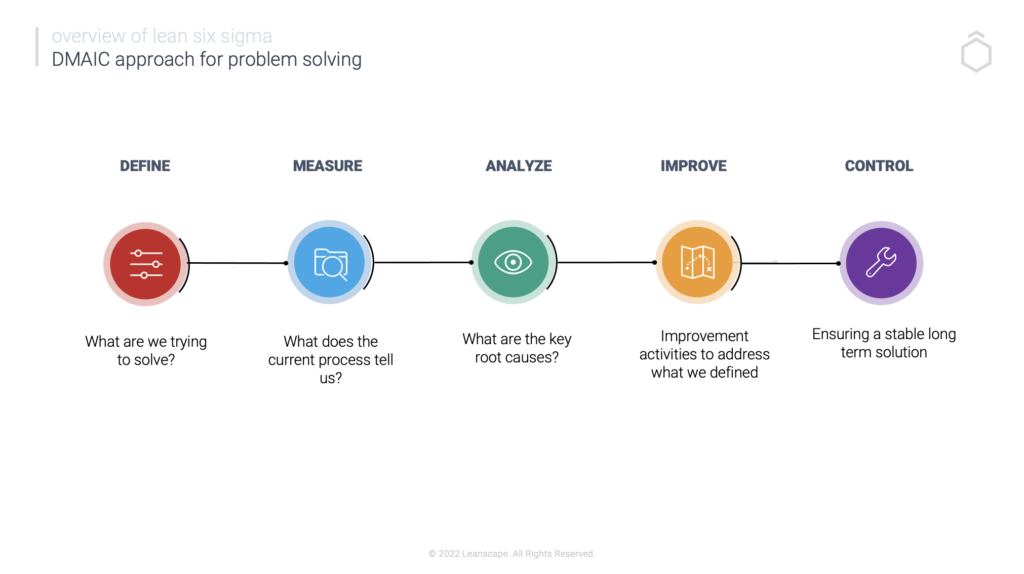
DMAIC – The 5 DMAIC Process Phases
The phases throughout the DMAIC model have and can be broken down in many different ways. One of the best approaches we have found is from Opex Resources which shows how to examine the existing processes, and with a project team, and the sigma improvement process, we can solve complex issues.
DMAIC Define Phase
The purpose of the Define phase is ultimately to describe the problems that need to be solved and for the key business decision-makers to be aligned on the goal of the project. Its about creating and agreeing the project charter .
All too often, teams have identified solutions without actually defining what it is they will actually be trying to do or perhaps not do. This can lead to internal confusion and often solutions which completely miss the business requirements and needs.
- Define the Business Case
- Understand the Consumer
- Define The Process
- Manage the Project
- Gain Project Approval
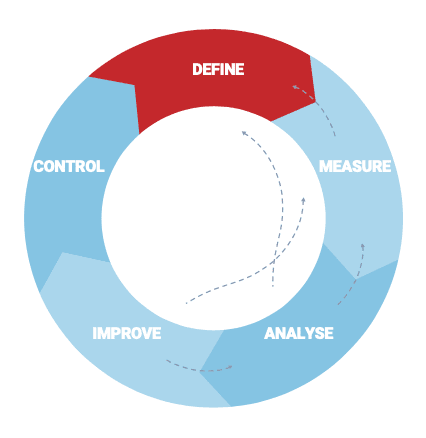
We can’t solve problems by using the same kind of thinking we used when we created them” Albert Einstein Tweet
DMAIC Analyse Phase
The goal of the DMAIC Analyse phase with the lean six sigma improvement process is to identify which process inputs or parameters have the most critical effect on the outputs. In other words, we want to identify the root cause(s) so that we know what critical elements we need to fix.
During this phase, the teams need to explore all potential root causes using both analytical approaches, statistical approaches or even graphical tools such as VSM’s and Process maps to uncover the most important elements which need to be changed/fixed.
The Analyse phase can be broken down into:
- Analyse the Process
- Develop Theories and Ideas
- Analyse the Data
- and finally, Verify Root Causes
DMAIC Improve Phase
The goal of the improvement phase is to identify a wide range of potential solutions before identifying the critical solutions which will give us the maximum return for our investment and directly fix the root cause we identified.
During this phase, the team brainstorm, pilot, test and validate potential improvement ideas before finally implementing the right solutions. With each pilot, the team can validate how well it improves the key measures they identified back in Define and Measure. When the team finally roll out the solution, the results should be seen if the right solution has been found and implemented correctly.
The Improve phase can be broken down into:
- Generate Potential Solutions
- Select the Best Solution
- Assess the Risks
- Pilot and Implement
DMAIC Control Phase
The final part of the DMAIC Model is the Control phase where we need to ensure that the new changes become business as normal and we do not revert to the same way of working as before.
During this phase, we want to ensure that we close the project off by validating the project savings and ensuring the new process is correctly documented. We also need to make sure that new measures and process KPI’s are in place and, finally that we get the business champion to sign off on both the project and the savings. We may need to redesign the workplace following the 5S principles .
The Control phase can be broken down into:
- Implement Ongoing Measurements
- Standardise Solutions
- Quantify the Improvement
- Close The Project
The key closing documents of the Control Phase is a Control Plan that documents all the changes and process steps with key risks, standard work instructions and the Project Close-Out document signed by the business owners to accept the change and the validated benefits.
Our approach to DMAIC follows Quentin Brook’s book “Lean Six Sigma & Minitab” which for anyone wishing to study Lean Six Sigma is a must for the Green Belt Course and the Black Belt Course .
The dmaic model vs. a3 management vs. 8d problem solving.
The DMAIC model is not the only project management roadmap. Two others which are important is the A3 format which originally comes from Toyota and is very Lean focused and the 8D which draws more of the DMAIC structure but with the 1-page idea of the A3.
Everyone has their own preference but each method is interchangeable. The DMAIC Structure lends its self naturally to a multi-slide Powerpoint presentation. Whereas the A3 is a single-page document which is perfect for internal communication and adding into War Rooms and Control Towers.
What’s important is that every problem-solving approach follows the PDCA (Plan, Do, Check and Act) Scientific Problem Solving format. The reset is just a preference or using the right tool in the right circumstances.
- Corporate Training
- Courses for Individuals

Our Newsletter

Reagan Pannell
Reagan Pannell is a highly accomplished professional with 15 years of experience in building lean management programs for corporate companies. With his expertise in strategy execution, he has established himself as a trusted advisor for numerous organisations seeking to improve their operational efficiency.
Our Training Courses
Fundamentals of lean.
- Lean Six Sigma White Belt Course
- Lean Thinking Business Course
- Lean Six Sigma Yellow Belt Course
- Lean Six Sigma Green Belt Course
- Lean Six Sigma Black Belt Course
Yellow Belt Course

View all courses
Recent articles.

Unveiling the Secrets of Blue Ocean Strategy for Business Growth

The Difference Between Strategy and Strategic Execution

Small Steps, Big Gains: The Case for Incremental Improvement

Maximising Efficiency and Profitability: Exploring the Benefits of Lean Consultancy

Empowering Leaders: The Imperative for Problem-Solving Training

Importance of Free Online Courses in Business Management
View all articles, green belt course.

Other Articles

How to Optimize Your Business Processes for Maximum Efficiency and Profit

Harnessing the Power of the Leadership Circle Profile | Leadership

10 Reasons Operational Excellence Deployments Fail

Project Management Key Skills: A Lean Perspective

How To Get Lean Six Sigma Certified In New York

Optimizing Efficiency: Inside the Toyota Production System

One Piece Flow and How it Reduces Waste and Increases Productivity

Principle 3: Learn to Make Pull | Principles of Lean

A Kruskal-Wallis Test Overview

05 – Work to Establish Standardised Processes

Murphy’s Law, Poka Yoke & Lean in Hospitals

Redefining Automation: Prioritizing Standardization and Optimization
Related articles.

Online Business Courses Free: The Benefits for Professionals

03 – Learn to Fail | Principles of Lean

What are some of the benefits of using Benchmarking in Lean Six Sigma?

An Introduction to the Central Limit Theorem

Breaking Barriers and Fostering Collaboration
Lean six sigma online courses.
FREE COURSE | YELLOW BELT | GREEN BELT | BLACK BELT | MASTERCLASS | WORKSHOPS
Ready to start your journey into the world of Lean with this free course?
FREE COURSE
LSS White Belt
Looking to get your first recognised Lean Six Sigma Certificate
Lean Thinking
A Lean focused continious improvement certification course
LSS Yellow Belt
Propel your career forward, tackle complex problems and drive change
LSS Green Belt
The ultimate fast-track for future leadership
LSS Black Belt
Become an expert in change management and complex problem-solving.
Subscribe to Newsletter
Keep up to date to the latest insights, courses, training, webinars and more. Join our newsletter today.
Lean Accelerator Program
Discover the power of problem-solving, 15 min per day | 3-months | only $999 | learn from experts.
The Easy Guide to Solving Problems with Six Sigma DMAIC Method
The most commonly used methodology in Six Sigma is the DMAIC process. Many use it to solve problems and identify and fix errors in business and manufacturing processes.
In this post, we will look at how to use the DMAIC process to solve problems. You will also find useful and editable templates that you can use right away when implementing DMAIC problem-solving in your organization.
- What are 5 the Steps of Six Sigma
DMAIC Process and Problem-Solving
Common mistakes to avoid when using six sigma dmaic methodology, how to use the dmaic methodology for problem solving in project management, what are the 5 steps of six sigma.
DMAIC is one of the core methodologies used within the Six Sigma framework. It is a data-driven method used to systematically improve the process. The approach aims to increase the quality of a product or service by focusing on optimizing the process that produces the output. This way DMAIC seeks to provide permanent solutions when it comes to process improvement.
It provides a structured problem-solving framework to identify, analyze, and improve existing processes. DMAIC guides practitioners through a series of steps to identify the root causes of process issues, implement solutions, and sustain the improvements over time.

Following we have listed down the 5 phases of the DMAIC process along with the steps you need to take when using it to solve problems. Different tools for each phase is provided with editable templates.
Step 1: Define the Problem
So there’s a problem that affects your customer or your company processes. In this first step of the DMAIC problem solving method , you need to focus on what the problem is and how it has affected you as a company.
There are a few steps you need to follow in this phase.
• Create a problem statement which should include a definition of the problem in quantifiable terms and the severity of the problem.
• Make sure necessary resources such as a team leader and competent team members, and funds etc. are available at hand.
• Develop a goal statement based on your problem statement. It should be a measurable and time-bound target to achieve.
• Create a SIPOC diagram which will provide the team with a high-level overview of the process (along with its inputs, outputs, suppliers, and customers) that is being analyzed. You can also use a value stream map to do the same job.
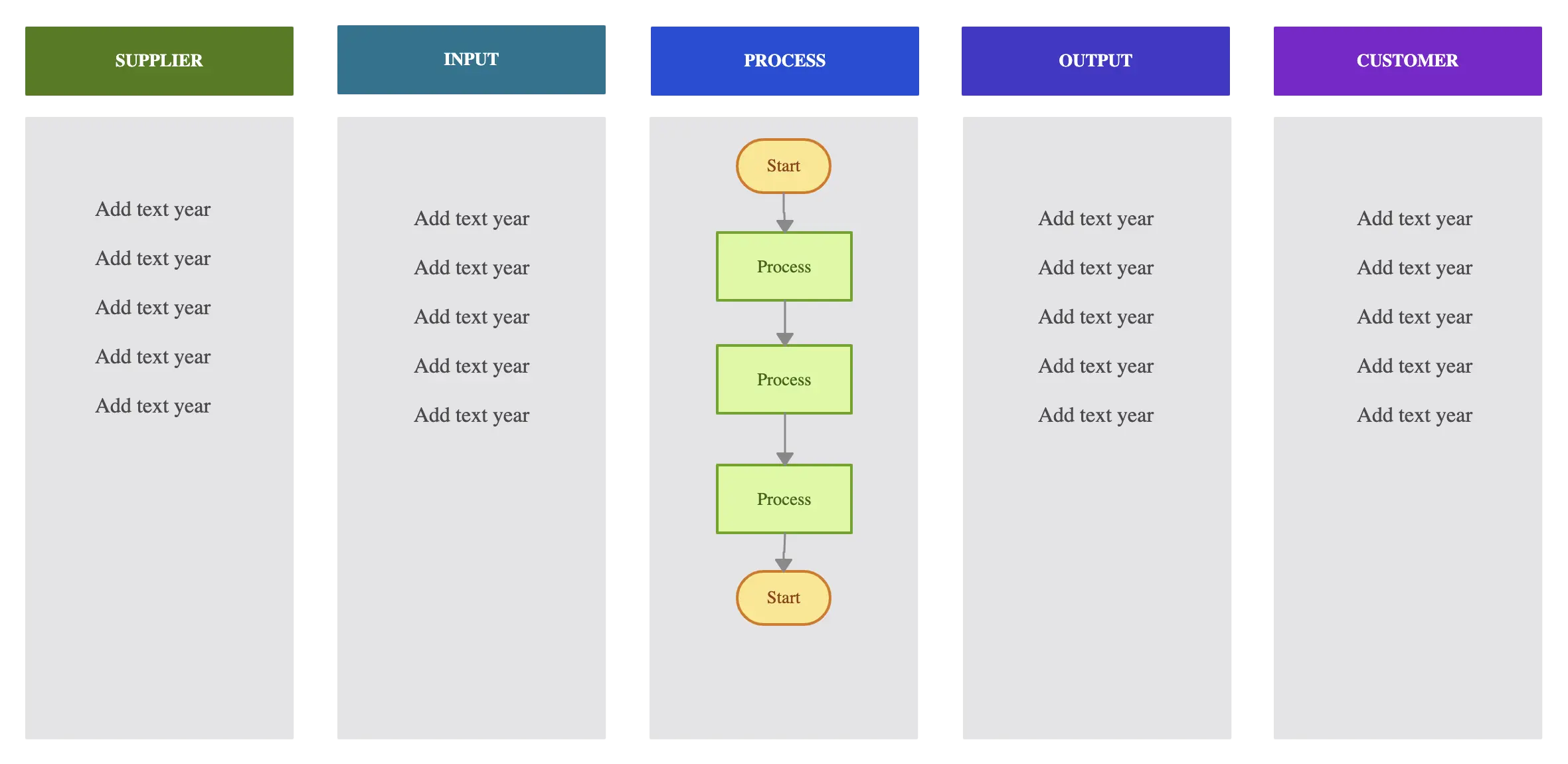
• Try to understand the process in more in-depth detail by creating a process map that outlines all process steps. Involve the process owners when identifying the process steps and developing the map. You can add swimlanes to represent different departments and actors responsible.
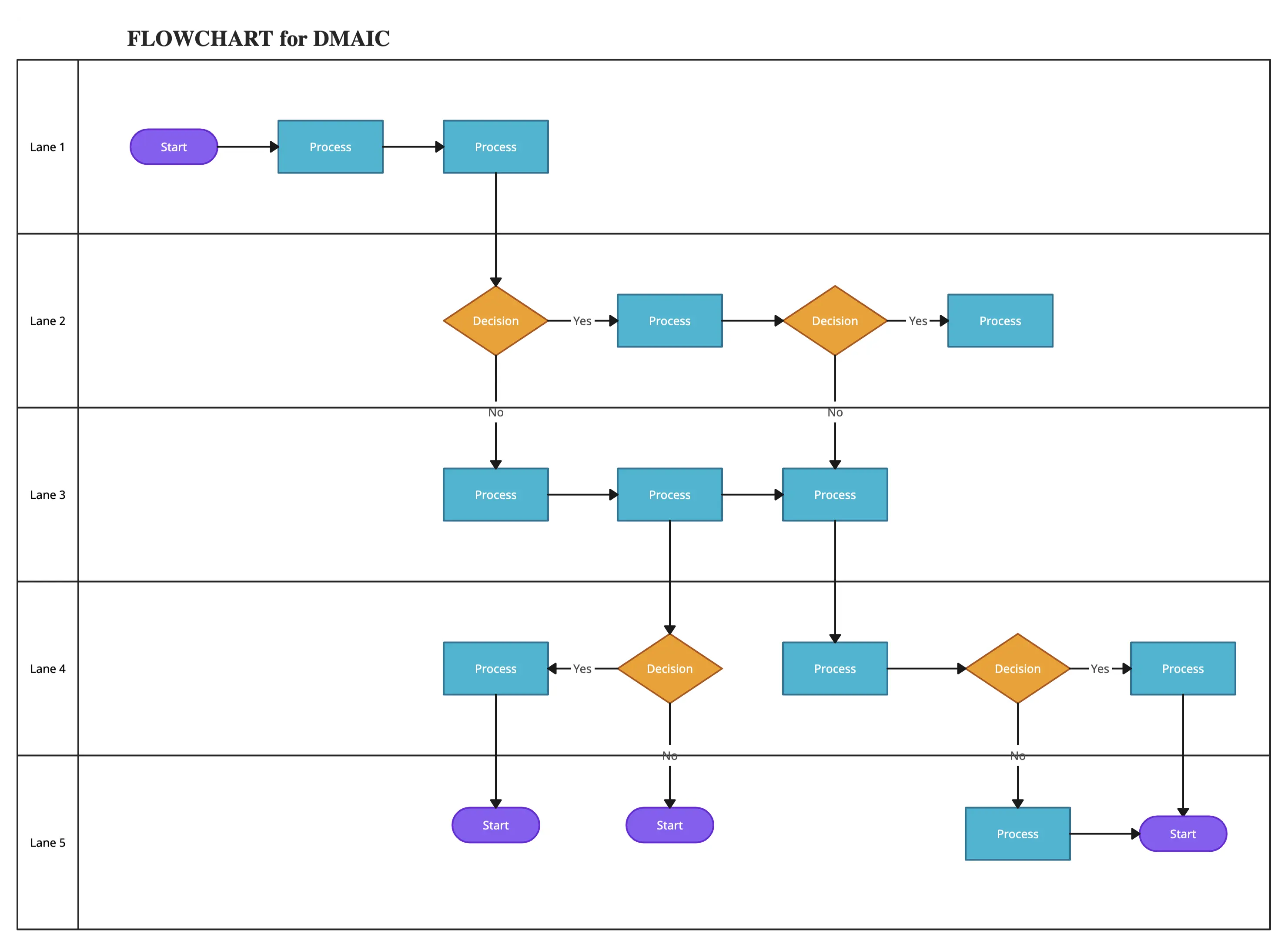
Step 2: Measure the Problem
In this step, you should measure the extent of the problem. To do so you need to examine the process in its current state to see how it performs. The detailed process map you created in the ‘Define’ phase can help you with this.
The baseline measurements you will need to look into in this phase, are process duration, the number of defects, costs and other relevant metrics.
These baseline measurements will be used as the standards against which the team will measure their success in the ‘Improve’ phase.
Step 3: Analyze the Problem
The analyze phase of the DMAIC process is about identifying the root cause that is causing the problem.
• Referring to the process maps and value stream maps you have created, further, analyze the process to identify the problem areas.
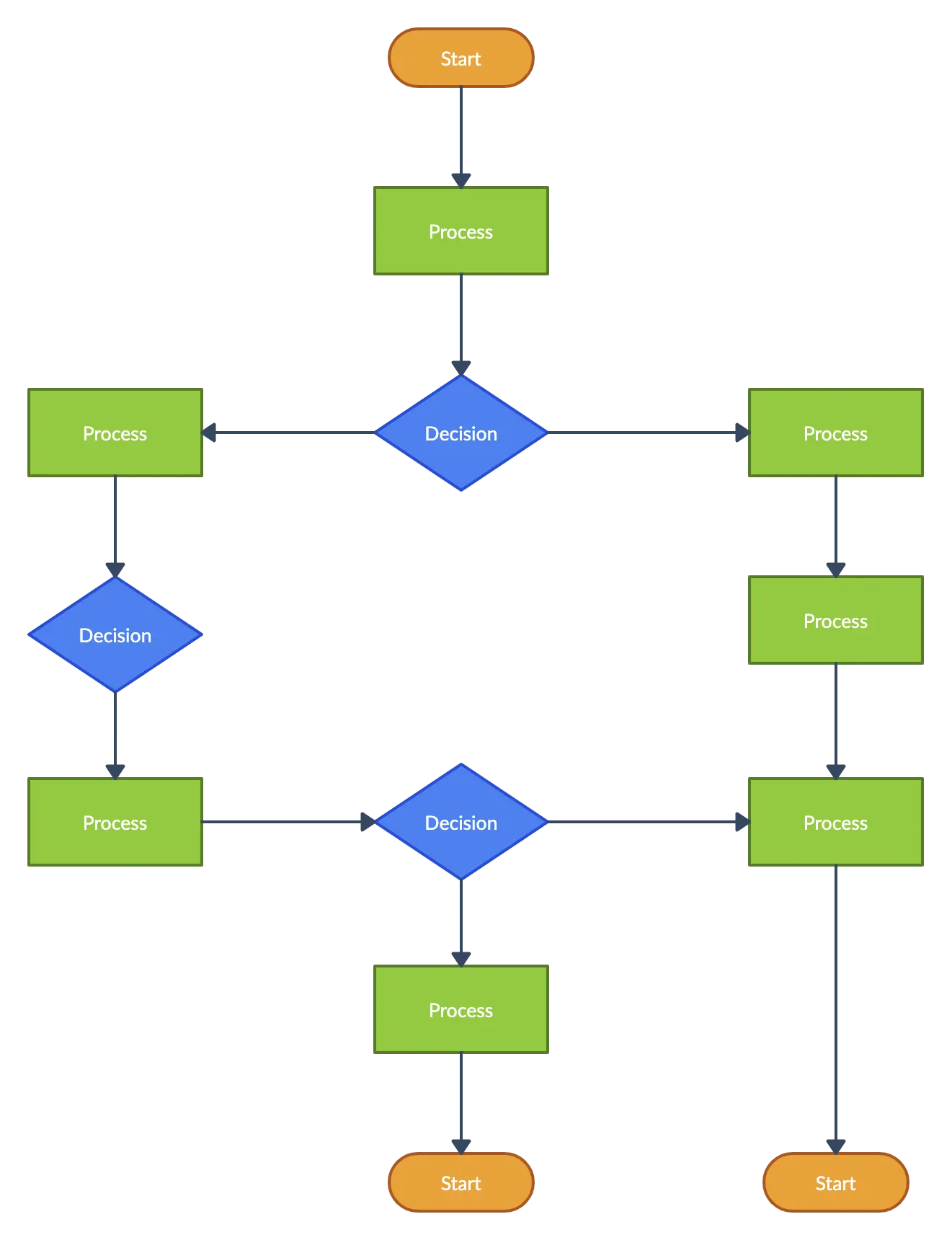
• Visualize the data you have collected (both in the ‘Measure’ phase and the analyze phase) to identify signs of problems in the processes.
• Use Pareto charts, histograms, run charts etc. to represent numerical data. Study them with team leaders and process owners to identify patterns.
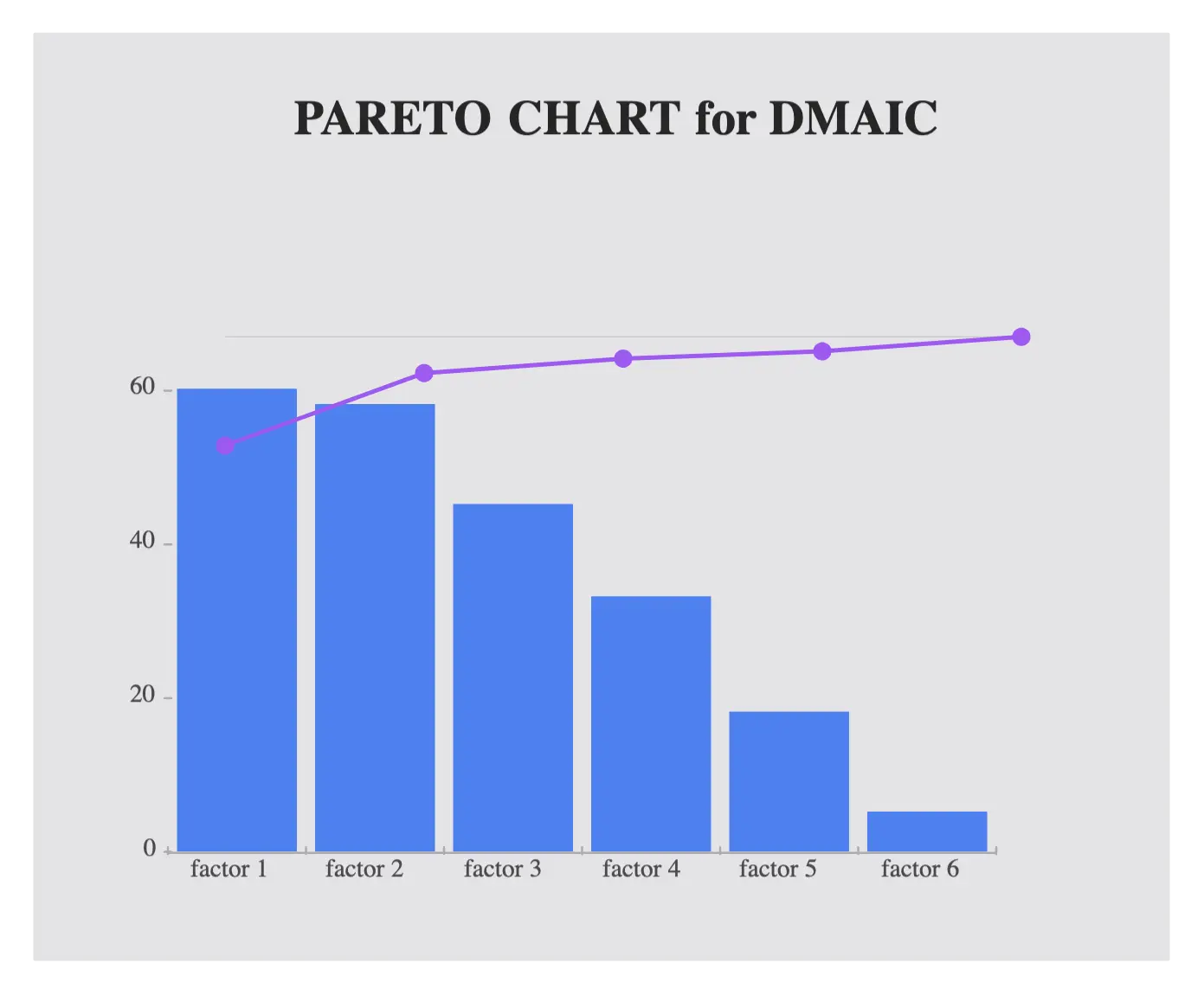
• With the results of your process analysis and your data analysis, start brainstorming the root causes of the problem. Use a cause and effect diagram/ fishbone diagram to capture the knowledge of the process participants during the session.

• Using a 5 whys diagram, narrow down your findings to the last few causes of the problem in your process.
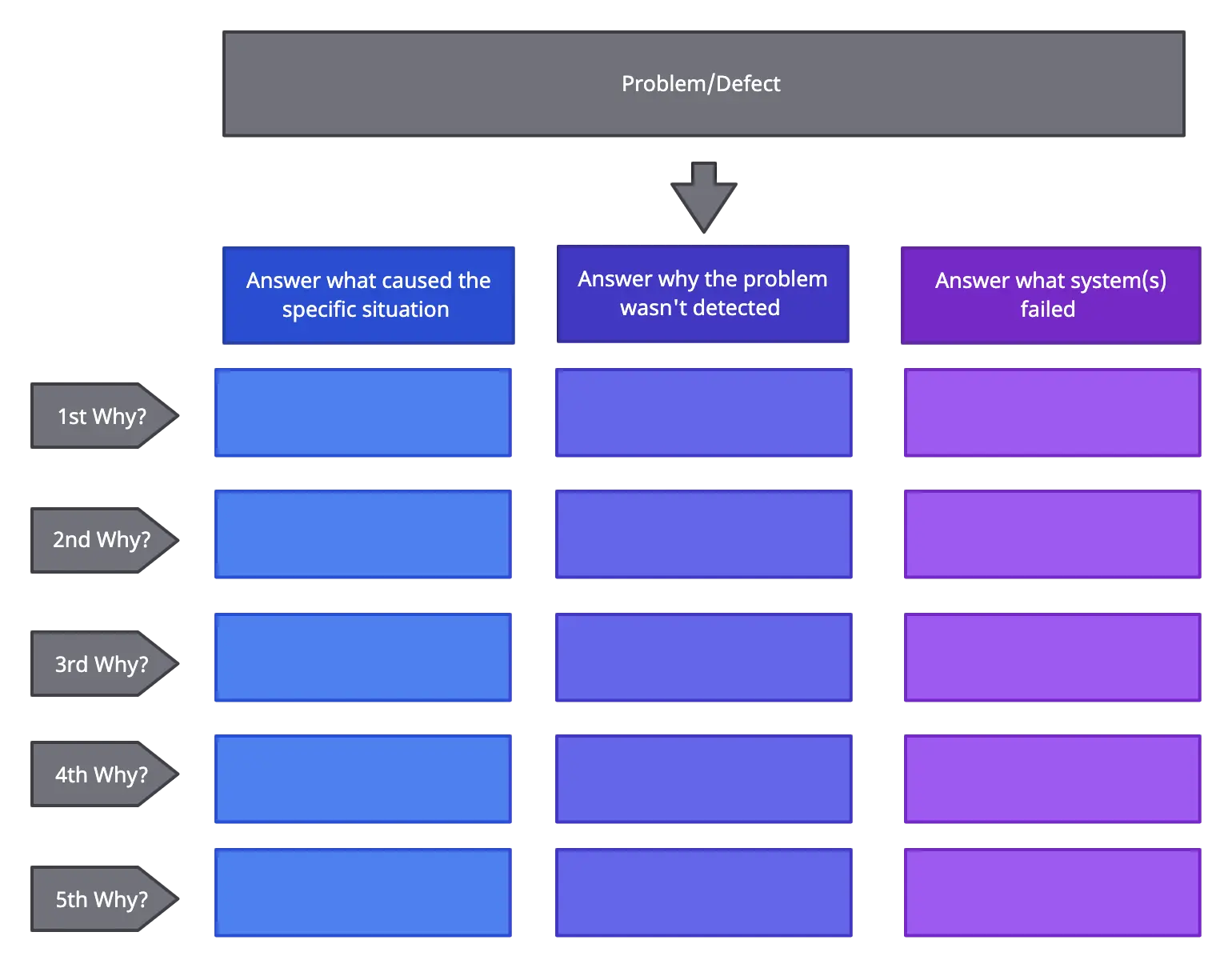
Step 4: Improve (Solve the Problem)
In this phase, the focus is on mitigating the root cause identified and brainstorming and implementing solutions. The team will also collect data to measure their improvement against the data collected during the ‘Measure’ phase.
• You may generate several effective solutions to the root cause, but implementing them all would not be practical. Therefore, you will have to select the most practical solutions.
To do this you can use an impact effort matrix . It will help you determine which solution has the best impact and the least effort/ cost.
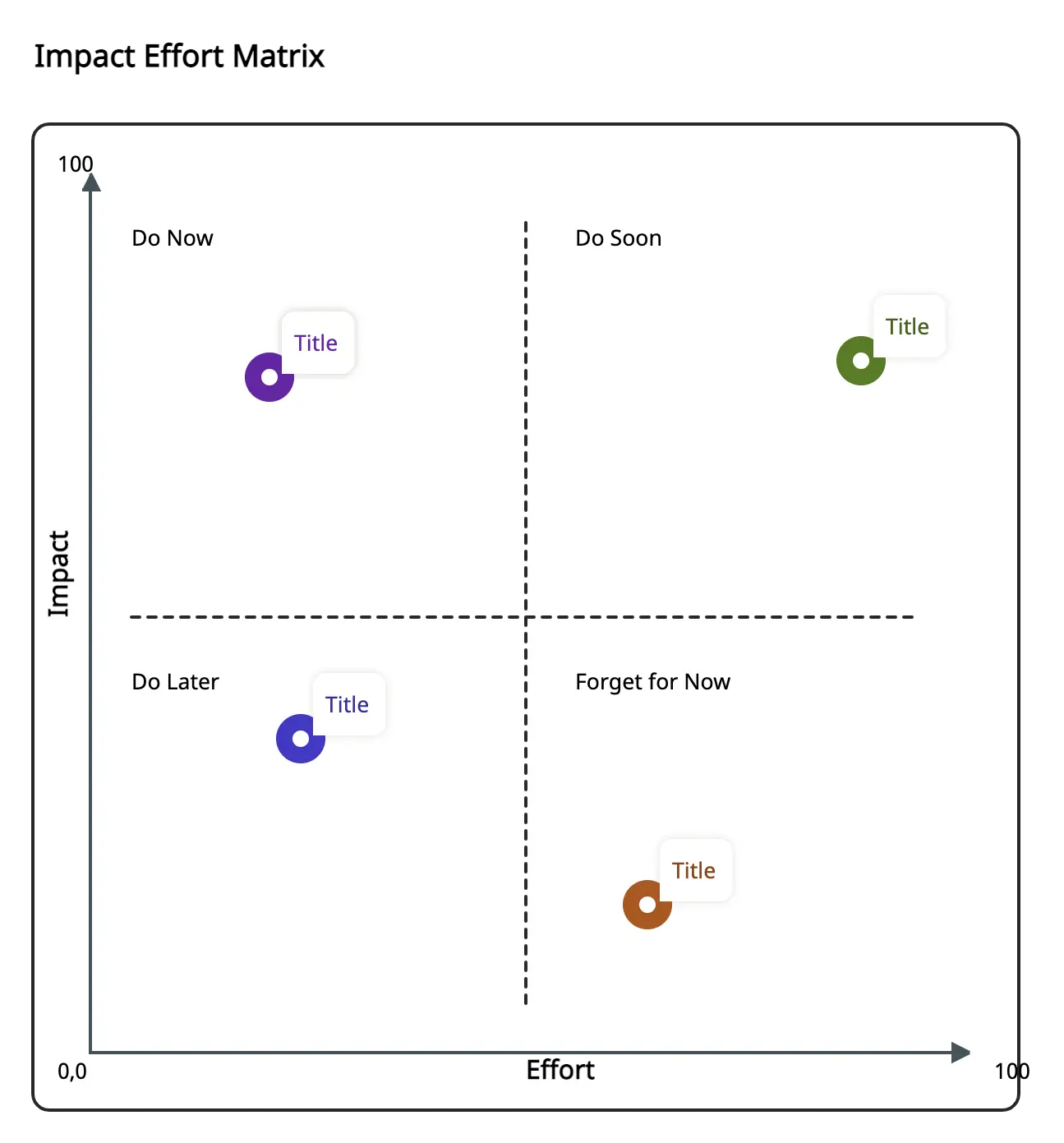
• Based on different solutions, you should develop new maps that will reflect the status of the process once the solution has been applied. This map is known as the to-be map or the future-state map. It will provide guidance for the team as they implement changes.
• Explore the different solutions using the PDCA cycle and select the best one to implement. The cycle allows you to systematically study the possible solutions, evaluate the results and select the ones that have a higher chance of success.
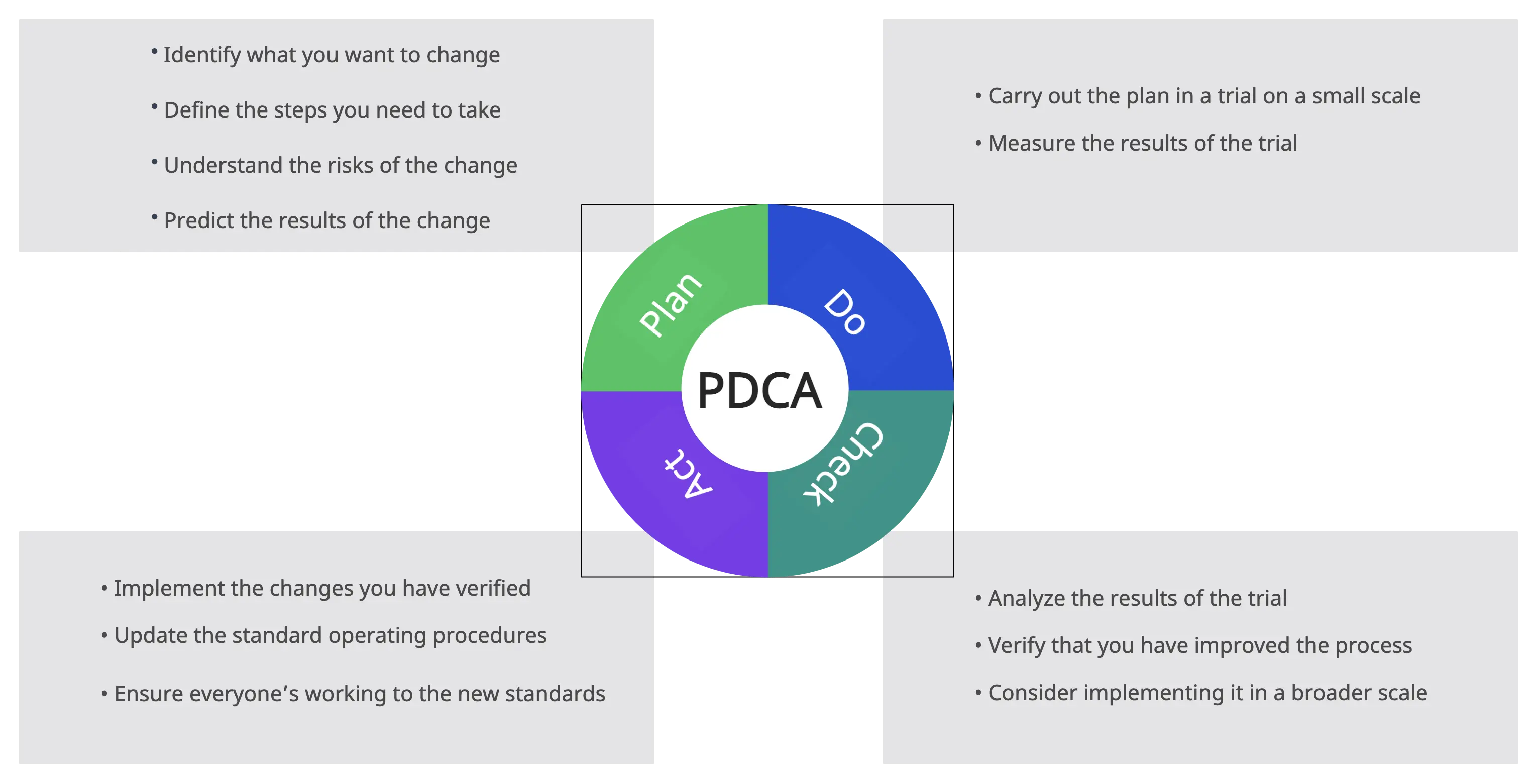
Step 5: Control (Sustain the Improvements)
In the final phase of the DMAIC method , the focus falls on maintaining the improvements you have gained by implementing the solutions. Here you should continue to measure the success and create a plan to monitor the improvements (a Monitoring plan).
You should also create a Response plan which includes steps to take if there’s a drop in the process performance. With new process maps and other documentation, you should then proceed to document the improved processes.
Hand these documents along with the Monitoring plan and the response plan to the process owners for their reference.
Insufficiently defining the problem can lead to a lack of clarity regarding the problem statement, objectives, and scope. Take the time to clearly define the problem, understand the desired outcomes, and align stakeholders' expectations.
Failing to engage key stakeholders throughout the DMAIC process can result in limited buy-in and resistance to change. Ensure that stakeholders are involved from the beginning, seeking their input, addressing concerns, and keeping them informed about progress and outcomes.
Collecting insufficient or inaccurate data can lead to flawed analysis and incorrect conclusions. Take the time to gather relevant data using appropriate measurement systems, ensure data accuracy and reliability, and apply appropriate statistical analysis techniques to derive meaningful insights.
Getting caught up in analysis paralysis without taking action is a common pitfall. While analysis is crucial, it’s equally important to translate insights into concrete improvement actions. Strive for a balance between analysis and implementation to drive real change.
Failing to test potential solutions before implementation can lead to unintended consequences. Utilize methods such as pilot studies, simulation, or small-scale experiments to validate and refine proposed solutions before full-scale implementation.
Successful process improvement is not just about making initial changes ; it’s about sustaining those improvements over the long term. Develop robust control plans, standard operating procedures, and monitoring mechanisms to ensure the gains achieved are maintained and deviations are identified and corrected.
Applying DMAIC in a one-size-fits-all manner without considering the organization’s unique culture, context, and capabilities can hinder success. Tailor the approach to fit the specific needs, capabilities, and culture of the organization to enhance acceptance and implementation.
In the project management context, the Define phase involves clearly defining the project objectives, scope, deliverables, and success criteria. It entails identifying project stakeholders, understanding their expectations, and establishing a project charter or a similar document that outlines the project’s purpose and key parameters.
The Measure phase focuses on collecting data and metrics to assess the project’s progress, performance, and adherence to schedule and budget. Key project metrics such as schedule variance, cost variance, and resource utilization are tracked and analyzed. This phase provides insights into the project’s current state and helps identify areas that require improvement.
The Analyze phase involves analyzing the project data and identifying root causes of any performance gaps or issues. It aims to understand why certain project aspects are not meeting expectations. Techniques such as root cause analysis, Pareto charts, or fishbone diagrams can be used to identify factors impacting project performance.
In the Improve phase, potential solutions and actions are developed and implemented to address the identified issues. This may involve making adjustments to the project plan, reallocating resources, refining processes, or implementing corrective measures. The goal is to optimize project performance and achieve desired outcomes.
The Control phase focuses on monitoring and controlling project activities to sustain the improvements made. It involves implementing project control mechanisms, establishing performance metrics, and conducting regular reviews to ensure that the project remains on track. Control measures help prevent deviations from the plan and enable timely corrective actions.
What are Your Thoughts on DMAIC Problem Solving Method?
Here we have covered the 5 phases of Six Sigma DMAIC and the tools that you can use in each stage. You can use them to identify problem areas in your organizational processes, generate practical solutions and implement them effectively.
Have you used DMAIC process to improve processes and solve problems in your organization? Share your experience with the tool with us in the comment section below.
Also, check our post on Process Improvement Methodologies to learn about more Six Sigma and Lean tools to streamline your processes.
Join over thousands of organizations that use Creately to brainstorm, plan, analyze, and execute their projects successfully.
FAQs about Six Sigma and DMAIC Approaches
DMAIC and DMADV are two methodologies used in Six Sigma. DMAIC is employed to enhance existing processes by addressing issues and improving efficiency, while DMADV is utilized for creating new processes or products that meet specific customer needs by following a structured design and verification process.
- Used for improving existing processes
- Define, Measure, Analyze, Improve, Control
- Identifies problem areas and implements solutions
- Focuses on reducing process variation and enhancing efficiency
- Used for developing new products, services, or processes
- Define, Measure, Analyze, Design, Verify
- Emphasizes meeting customer requirements and creating innovative solutions
- Involves detailed design and verification through testing
Problem identification : When a process is not meeting desired outcomes or experiencing defects, DMAIC can be used to identify and address the root causes of the problem.
Process optimization : DMAIC provides a systematic approach to analyze and make improvements to processes by reducing waste, improving cycle time, or enhancing overall efficiency.
Continuous improvement : DMAIC is often used as part of ongoing quality management efforts. It helps organizations maintain a culture of continuous improvement by systematically identifying and addressing process issues, reducing variation, and striving for better performance.
Data-driven decision making : DMAIC relies on data collection, measurement, and analysis. It is suitable when there is sufficient data available to evaluate process performance and identify areas for improvement.
Quality control and defect reduction : DMAIC is particularly useful when the primary objective is to reduce defects, minimize errors, and enhance product or service quality. By analyzing the root causes of defects, improvements can be made to prevent their occurrence.
More Related Articles

Amanda Athuraliya is the communication specialist/content writer at Creately, online diagramming and collaboration tool. She is an avid reader, a budding writer and a passionate researcher who loves to write about all kinds of topics.

How to Solve Your Problems With Lean Six Sigma (Free DMAIC Checklist)
Elisabeth Swan is the co-author of “The Problem-Solver’s Toolkit” and co-host of “The Just-in-Time Cafe Podcast.” She’s been a process improvement consultant, speaker, and innovator for over 30 years. She’s the Chief Learning Experience Officer for GoLeanSixSigma.com, a former cast member of ImprovBoston, and – if asked – may still be able to ride a unicycle.
Surgeon Atul Gawande made headlines when he told the world that a simple checklist could drastically reduce unnecessary deaths in The Checklist Manifesto .
Yet, checklists conjure images of forklift drivers on loading docks with clipboards counting boxes. How could they transform healthcare?
“ He has… produced a 90-second checklist which reduced deaths and complications by more than one-third in eight hospitals around the world – at virtually no cost and for almost any operation. ” – James Clarke, reviewing The Checklist Manifesto, Ulster Med J. 2011 Jan; 80(1): 54.
Aviation was transformed decades earlier when management and engineers at Boeing Corporation created the pre-flight checklist after the 1935 crash of the prototype Boeing B-17 at Wright Field in Dayton, Ohio. Checklists have become so essential to the airline industry that most crashes can be traced to the misuse or failure to complete a checklist.
A New York Times reviewer noted, “no matter how expert you may be, well-designed checklists can improve outcomes”. Since the purpose of process improvement is improving outcomes, Lean Six Sigma and checklists are natural companions.
To prove that, this Process Street blog post will show the relationship between checklists and lean six sigma, and provide you with a free DMAIC Improvement Project Tollgate Checklist that you can use right now.
Use the links below to jump to that section of the post:
Lean Six Sigma and the role of problem-solving
Lean six sigma & the checklist, introduction phase, define phase, measure phase, analyze phase, improve phase, control phase, checklists and lean six sigma, use process street to reduce error.
Or, if you just want the checklist, check it out below!
Let’s get started.
For those unfamiliar with Lean Six Sigma and process improvement, it is a structured approach for organizations to scrutinize how things are done, poke at data and processes to uncover waste and then cut out things like extra forms, out-dated approvals and other time-wasting steps.
It’s a customer-focused, 5-step problem-solving model that engages entire workforces to constantly seek a better way of doing things.
Proof of Lean Six Sigma’s influence is evident in today’s hiring practices. A poll by GoLeanSixSigma highlights that hiring managers prefer a person who is “ Green Belt Certified ” – having substantial Lean Six Sigma skills – by an almost 80% margin. In an interview with the former head of Twitter, problem-solving emerged as the top skill sought by today’s most influential hiring managers.

In other words, problem-solving (especially via Lean Six Sigma) is an absolutely vital skill.
If problem-solving is a must-have skill and checklists are key to good outcomes, then combining the two makes sense.
DMAIC – Define, Measure, Analyze, Improve & Control – is the 5-Step model for Lean Six Sigma and there’s a set of required tollgates at the end of each phase. These tollgates outline what has to be done in order to move the problem-solving process forward.
Using the tollgates as an outline, we created a dynamic Process Street template that you can use for free and run checklists from to track your progress!
Before you can start solving problems, you need a problem to solve.
Picking a process issue – and finding someone in leadership to support you – are two required tasks in this first tollgate. Scoping the project is important (bigger than a “just-do-it” and smaller than “solving world hunger”) but even more critical is finding a Sponsor.
Finding a Sponsor
In a poll asking Lean Six Sigma practitioners what they considered the biggest obstacle to process improvement success, “Getting Leadership Support” accounted for almost a third.
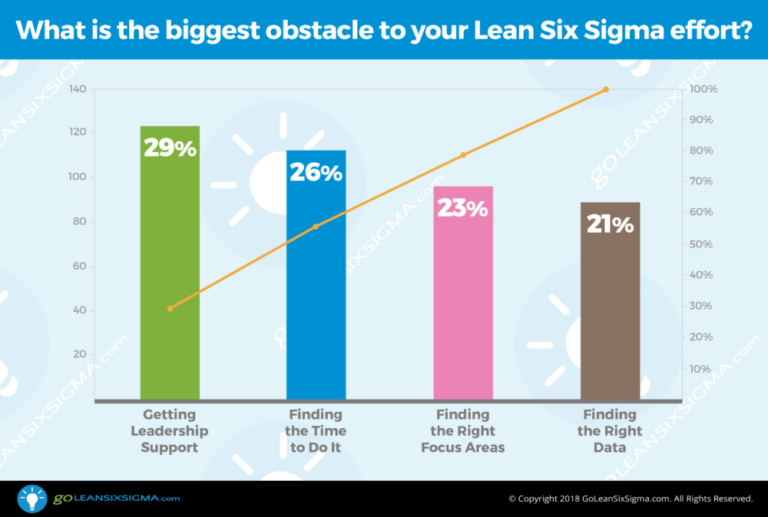
When we coach team leads who tell us they can’t find someone to back their project, we let them know, “No Sponsor, no project”. If nobody in charge has any skin in the game, there’s no point in attempting the process fix. Find a different project that leadership supports.
One thing that helps when searching for leadership backing is being able to explain what Lean Six Sigma is and why it makes a difference. Since the checklist template is dynamic we inserted a video in the Define Phase within the checklist item, “Enlist a Project Champion/Sponsor who will support you and the project”. The team lead can share the video with managers or directors who they consider Sponsor candidates.

There’s also a Project Selection Guide Template embedded in the checklist so users can take a project idea and put it through a few screening questions. Is it a repeating problem? Is there a way to measure it? The checklist serves as a reminder, a source of templates, supporting videos and other just-in-time guidance.
The next set of tollgate tasks cover the Define Phase of DMAIC. This is where problem-solvers clarify the problem, the process impacted and customers of the process.
There is a journey of discovery during this phase as everyone agrees on the issue to solve. One of the big challenges is the tendency of ambitious team leads—or equally ambitious Sponsors—to try to “shoot the moon.”
Shooting the moon
They might want to reduce cycle time, reduce defects , improve margins, and increase customer satisfaction all by next Tuesday. But a project that focuses on everything accomplishes nothing. It’s okay to measure the cost reduction that results from reducing defects. But pick one of those to be the goal. Success is more possible if you focus on one goal at a time .
It takes practice and discipline to develop a manageable goal statement. Another moon shot is aiming for perfection out of the starting gate. When we see a goal statement that claims the team will, “reduce defects from 25% to 0%” then we know there is a sizable risk of failure and disappointment.
That’s why the Define Phase of the checklist includes a Goal Builder Template along with a blog providing tips on how to create well-crafted goal statements.

The primary focus of the Measure Phase is to baseline the process. If you’re trying to reduce defects, you need to know how you’re doing at that now. What’s your track record? You need to know the baseline of the process in order to measure whether or not you made a difference with your improvement when you get to the Improve Phase.
You need to know the gap, so you can close the gap.
The data’s in the system, somewhere…
One of the issues we run into in this phase is problem solvers assuming that data is sitting in a system somewhere waiting to be accessed. If they simply run a report, they’ll have the baseline. Check that off the list. But that rarely goes according to plan.
Maybe there’s system data, but was it entered with care? Is it reliable? We’ve seen teams struggle to use data that didn’t make sense. They could access cycle time data, but it didn’t take into account that the workday ended at 5:00. I had another team looking at why healthcare invoices had to be manually adjusted. They looked up the defect codes and the biggest category was “Other”. System data existed, but it was useless.
Most of the time, it helps to collect some data manually. In order to think through your approach, you need a Data Collection Plan. That involves listing the data you want and considering things like stratification factors—the “who, what, when, where” of data. If you’re looking at defects, should you collect data on defects by product? Defects by the fields on a form? Defects by customer type?
Within the task: “Develop a Data Collection Plan with Operational Definitions and create Check Sheets as Needed”, we’ve embedded a template (The Data Collection Plan) and a video to guide the process.
You’ll learn a lot by collecting the data firsthand, so if the perfect data set is not magically sitting in the system, it helps to have a plan.
Analyze is the crux of the DMAIC method. This is where learners drill down and discover the root cause of the process problem they’ve been chasing. Once you do that, you can solve the problem for good.
But if you have not determined the root cause then you might be solving a “symptom,” putting a bandaid on the problem or implementing a change based on a hunch. All of this means there’s a high likelihood the problem will remain and the efforts will have been in vain.
Finding the smoking gun
If you’ve always been told, “don’t bring me a problem, bring me a solution,” that’s an encouragement to jump right past this step into the fun of solutions. I’ve seen teams go with their assumptions regardless of what the data says or the process analysis reveals. I’ve seen Sponsors who tell teams what solutions they want to be implemented right from the get-go.
How do you stick with analysis long enough to find the smoking gun? The trick is to keep collecting the clues in the Cause & Effect Diagram , aka The “Fishbone Diagram”. It’s an aptly named tool, popularized by Dr. Ishikawa , which resembles a fish skeleton. Its construction allows teams to develop root cause theories around a problem as they build their knowledge of the process.
Each time they collect data, interview process participants on a Gemba Walk or map the process steps, they uncover potential reasons for defects. Making the most of the Fishbone Diagram is key but, during a poll, users reported where they fell short.
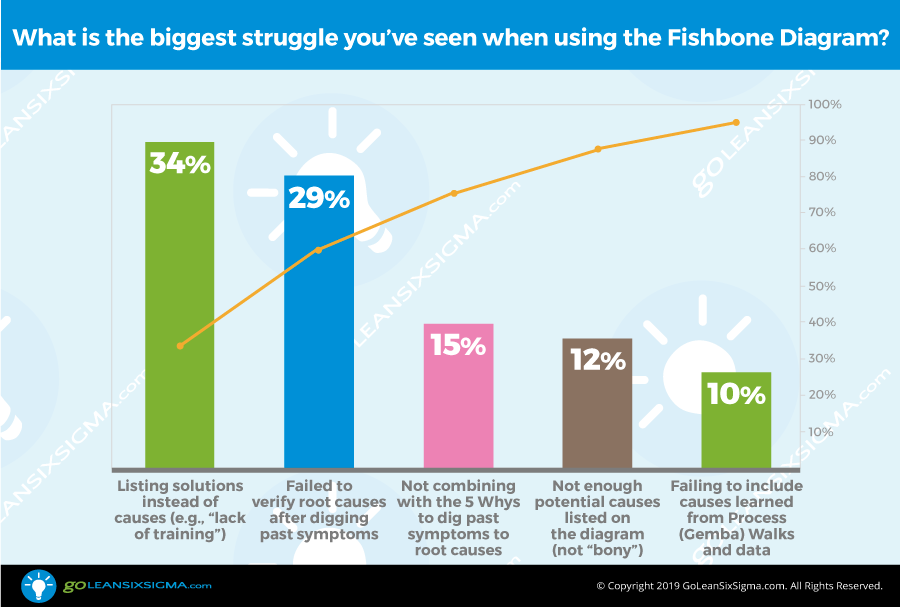
Solutions masquerading as problems
Over a third of respondents reported the issues of “listing solutions” on the Fishbone instead of causes. What we hear are phrases like, “the root cause is a lack of training”.
The problem with “lack of” anything is that it’s a sneaky way of putting a solution on the Fishbone.
The question is, “what is the training addressing?” Is it lack of user knowledge? If that’s the problem, could it be solved with helpful visuals, a simpler process? There are a lot of ways to address user knowledge before jumping to more employee training.
This is when you want to behave like the persistent detective – think Columbo, the classic 70’s TV icon. Every question helps you accumulate clues. People working through the process may have the answer without knowing it. The trick is to keep looking upstream until you find potential culprits. Dig past the symptoms.
To help with this phase, the checklist includes both a Fishbone Diagram Template as well as a video on how to get the most out of the Fishbone.
The Improve Phase is a long-anticipated step in the journey. It’s the step teams generally want to jump to from the start. Testing countermeasures, piloting solutions, watching the problem disappear, that’s the fun of process improvement. If you’ve done a proper job of Define, Measure, and Analyze, this phase falls nicely into place.
The ripple effect
The catch? Unintended consequences.
If you toss a stone into a lake you can see the ripples flow out from the center. The same principle holds true for process change. If you remove a step, change a form, skip an approval , will things fall apart? For that, we look to the Failure Modes & Effects Analysis or FMEA for short.
It’s a methodical way of assessing the potential for things to go wrong. It Involves deciding the potential severity and frequency of future problems and then mistake-proofing the process to prevent them. The technique originated at NASA since they couldn’t risk trial and error when sending men to the moon. By thinking through the risks of change they developed the kind of contingency plans you saw on display in movies like Apollo 13.
That’s why there’s an FMEA Template and a video on how to use it tucked into the main checklist from this post.
It’s okay to make changes. It’s simply key to think through the impact of those changes on other parts of the business.
Process Improvement can happen quickly and have a dramatic impact, but it’s critical to “stick the landing.” The Control Phase exists to see the improvement through to stability.
If teams move on and everyone takes their eyes off the ball, things may start to slip. What they need is the ability to continuously see the performance of the new process.
Sticking the landing
Have you ever tried to watch a game without a scoreboard? How would you know who was winning? Or how much time was left?
It’s the same with process work.
How does your team know how they’re doing? How do you stay aware of how the new process is performing?
By making the data visible.
Keeping an eye on Process Performance can be done with a single metric — you need to focus on one thing. If the goal was to reduce defects, then the single metric would be tracking the daily percentage of defects. A great way to measure success is with a Control Chart.
Control Charts are time charts. You might know them as Line Charts or Run Charts. They include a measure of variation so they are often referred to as “Run Charts that went to college”. They can be created in Excel , but they can also be drawn by hand.
Teams often set up whiteboards in the shared workspace to track things like defects. People can rotate responsibility for updating the chart. If people can see the measure and are responsible for it—they pay attention to it. What gets measured gets managed.
The Control Chart Template is embedded in the checklist for the Control Phase.
Process Improvement is a mainstay of Operational Excellence and checklists are simple but effective ways to make sure you get the outcomes you want. The following quote comes from the interim CEO/President of the Association for Manufacturing Excellence ( AME ).
“ I am a big fan of checklists for ensuring quality at the source. They serve an important purpose in reminding us of all that’s needed in a particular process or project. Without checklists, we risk missing or overlooking something by mistake. Checklists work best when ticking off items as they are completed, not en masse once the entire project is done. The key point is to use and follow them, not “pencil-whip” them from memory after the fact. While not foolproof, checklists can help us cover the details and result in more thorough, successful improvement efforts. ” – Jerry Wright , President, AME
Checklists have transformed healthcare, aviation, and countless other industries. Run this Process Street DMAIC Tollgate Checklist and make sure your next improvement effort gets great results.
Process Street is a powerful piece of workflow software that lets you crush the human error in your organization.
By creating process templates (like the free DMAIC checklist in this post) you can give your whole team a central location for them to see what they have to do, and how exactly they should do it.
No more confusion, no more errors.
Take advantage of our powerful feature set to create superpowered checklists, including:
- Form fields
- Conditional logic
- Variable user permission levels
- Exporting and printing templates
- And much, much more!
Check out our intro webinar to see the app in action!
Stop leaving the success of your processes up to chance. Get started with a free trial of Process Street today!
How do you manage quality control in your business? Let us know in the comments!
Get our posts & product updates earlier by simply subscribing
Ben Mulholland
Ben Mulholland is an Editor at Process Street , and winds down with a casual article or two on Mulholland Writing . Find him on Twitter here .
Leave a Reply Cancel reply
Your email address will not be published. Required fields are marked *
Save my name, email, and website in this browser for the next time I comment.
Take control of your workflows today

Six Sigma Basics: DMAIC Like Normal Problem Solving
Published: February 26, 2010 by Chew Jian Chieh

What is the usual way most people go about solving problems? Most people and organizations consciously or unconsciously use this method, as illustrated in Table 1 below.
This is not a bad method, provided what one thinks is causing the problem is really causing the problem. In this case, if a person is fat simply because they do not exercise enough and eat too much, then by exercising and eating less, they should weigh less. And if they do lose weight after taking such action, then the theory is validated. People solve a fair number of problems in this manner – using conventional wisdom and gut theories that also happen to be correct. In those cases, there is little need for Six Sigma – it is just a waste of time. Just do the above.
How Six Sigma Problem Solving Is Different
How is the Six Sigma problem-solving methodology different? Actually it is really not so different from how people normally go about solving day-to-day problems, except in Six Sigma, nobody knows what is really causing the problem at the beginning of the project. And because all attempts to solve the problem in the past have failed, largely because conventional wisdom and gut theories were wrong about the cause of that problem, people conclude that the problem cannot be solved.
These types of problems are really the best candidates for Six Sigma. The Six Sigma DMAIC methodology differs from conventional problem solving in one significant way. There is a requirement for proof of cause and effect before improvement action is taken. Proof is required because resources for improvement actions are limited in most organizations. Those limits preclude being able to implement improvement actions based on 100 hunches hoping that one hits the mark. Thus, discovering root causes is at the core of the methodology.
Here are the steps in the DMAIC process:
- Define phase: Understand what process is to be improved and set a goal.
- Measure phase: Measure the current state.
- Analyze phase: a) Develop cause-and-effect theories of what may be causing the problem; b) Search for the real causes of the problem and scientifically prove the cause-and-effect linkage
- Improve phase: Take action.
- Control phase: a) Measure to verify improvement has taken place; b) Take actions to sustain the gains.
Using a More Mathematical Language
The above steps can be phrase in another way – using more mathematical language (Table 2). (This kind of mathematical language should not put anyone off. If it is a concern initially, a person just needs to remember than whenever a Y shows up in any sentence, just replace it with word “effect,” or the phrase “outcome performance measure.” And whenever an X shows up , just replace it with the word “cause.”)
The key assumption in Six Sigma is this: If the true causes of any problem can discovered, then by controlling or removing the causes, the problem can be reduced or removed. Now is that not just common sense?
A Series of Common Sense Questions
In summary, Six Sigma DMAIC methodology is really just a series of common sense questions that one asks in order to solve any problem and eventually sustain the gains that come from solving the problem.
- Define: What is the Y that is not doing well?
- Measure: What is Y’s current performance?
- Analyze: What are the potential Xs? What are the real Xs?
- Improve: How can the real Xs be controlled or eliminated?
- Control: How can the Xs continue to be controlled to sustain the gains in Y?
Six Sigma’s DMAIC methodology is nothing but a search for the real causes of problems. With this understanding, what remains for those learning Six Sigma are the various tools and techniques used to answer these questions.
About the Author

Chew Jian Chieh

Six Sigma Study Guide
Study notes and guides for Six Sigma certification tests

Define Phase (DMAIC)
Posted by Ted Hessing
The Define phase (DMAIC) is the first phase of the Six Sigma improvement process and is critical to its success. As the name indicates, Define is about describing the problem and setting the project goal.

Six Sigma Phases
Six Sigma is a systematic problem-solving approach centered around defect elimination and variation reduction , which leads to process improvement.
One of the principal tools in Six Sigma is using the DMAIC methodology. (Also see DMAIC Overview). DMAIC is a logical framework that helps you think through and plan improvements to a process to achieve a Six Sigma level of excellence. Five phases of the DMAIC method.

Use the Define Phase of DMAIC to qualify a project to see if it is worth doing, if it is a good fit for the Six Sigma approach, and to set the stage for the project.
Like a good reporter, learn the background of what is being asked and focus on the 5Ws – Who, What, When, Where, and Why. This becomes evident when you use the tools below to identify scope, goals, and rationale.
Goals of Define Phase
- Understand the project, including its purpose and scope.
- Determine whether the process is a good candidate for DMAIC.
- Map the current process.
- Detail customer expectations.
- Estimate timelines and costs using project management tools
DMAIC Define Phase Overview
The Define phase is approximately 2 to 3 weeks based on the project inputs and begins with selecting the project champion.
The define phase is all about establishing the project, and there are many individual activities to complete. Multiple tools and concepts are available in the Define phase of Six Sigma.
Project Basics
What is Quality – The ASQ defines it like this:
A subjective term for which each person or sector has its own definition. In technical usage, quality can have two meanings: 1) the characteristics of a product or service that bear on its ability to satisfy stated or implied needs; 2) a product or service free of deficiencies. According to Joseph Juran, quality means “fitness for use”; according to Philip Crosby, it means “conformance to requirements.” ASQ Quality Glossary
Cost of Poor Quality : Cost of Poor Quality (CoPQ) is defined as the cost associated with providing poor-quality products or services. It is basically a combination of preventive, appraisal, internal, and external failure costs.
CTQ requirements: Critical requirements on process outputs and other critical process performance measures are called CTQ. Critical quality requirements related to customer expectations and needs around the output quality.
Causal Theory y=f(x): Causal theory, in Six Sigma terms, means that you create an output (y) from an input (x) and a function (f)
Process Performance Metrics
We can use many process performance metrics to measure our processes’ current and future value.
Defects per Opportunity (DPO) : DPO stands for Defects per opportunity. This is a simple ratio. Take the number of defects you have in your process (usually found by sampling) and divide it by however many opportunities there are.
Defects per Unit (DPU) : Defects per unit are a similar calculation to DPO, but instead of looking at opportunities, we’re looking at units.
Defects per Million Opportunities (DPMO) : DPMO is based on DPO but in real-world manufacturing type numbers. This is an important metric because it’s used in Six Sigma to measure the performance of a process. If you’ve already worked out DPO for a sample, you can calculate DPMO by simply multiplying the decimal result (not the percentage) by one million.
First-Time Yield (FTY) : First-time yield is the most common way to calculate the process yield. It is the number of defect-free units coming out of a process compared to the number of units manufactured. In other words, it is the probability of a defect-free output from a process.
Rolled Throughput Yield (RTY) : RTY provides a probability that a process with no defects will generate a unit. In other words, it’s the probability that a multi-step process will produce a defect-free unit.
Lean Metrics
Lean metrics are the measures that can be used to control and monitor the manufacturing processes such that continuous quality can be facilitated by identifying opportunities for improvements and changes.
Cycle time : Cycle time is the average time taken to complete a process per item . It is calculated as the reciprocal of the throughput rate. In other words:
Total Lead Time : Lead time is the total time taken for the work to process from one point to another in manufacturing. It is calculated as the time between two points, known as starting and endpoints.
Process Cycle Efficiency : Process cycle efficiency helps detect how much of the process actually adds value to the entire process.
Project Selection
Select a project with needs and criteria that are appropriate for using DMAIC . The problem could be anything that impacts the Key Performance Indicator (KPI) , like process output, customer satisfaction, production cost, defects, rework, cycle time, etc.
Project Cost/Benefit Analysis (CBA) : Cost/Benefits analysis examines the project’s projected costs and returns. It gives us data that we need to decide whether a project is worth doing.
Project Charter : A process charter is a high-level document that provides purpose and motivation for the initiative, serves as a working document for the team, and is a reference for the rest of the company. The project charter is the most important document in the Define phase of Six Sigma, and that will be updated throughout the DMAIC process.
A Project Charter should contain the following elements
- Business case
- Problem statement
- Project scope
- Goal statement
- Milestone/Deliverables
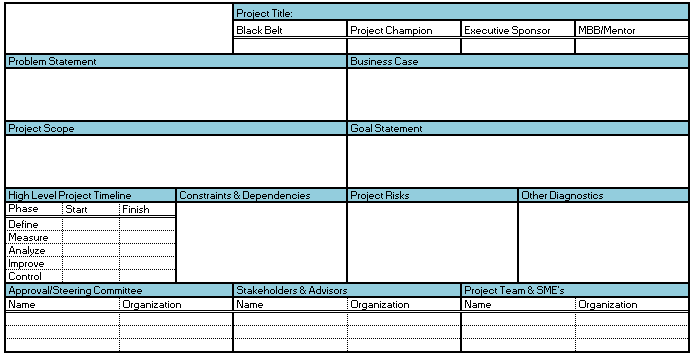
Organizations use various tools to make their goals achievable. SMART (Specific, Measurable, Assignable, Realistic, and Time-Bound) is a technique that helps to attain and track project goals.
Current State Process Analysis
SIPOC : A SIPOC is a high-level process mapping tool to help visualize a process and its influences. In other words, it is a useful tool that depicts how a process serves the customer and summarizes the inputs and outputs of a process in a visual format.
Flow chart: A process flowchart is a simple process map that visually represents the sequence of activities and their points of decision. These flowcharts provide the basic details of the process, which can later be augmented by adding different staff roles.
Swim Lane Flow Chart: These process maps provide the interactions between different departments and the roles performed by different people in the organization. Also termed ‘swim-lane’ charts, these process maps have vertical lines showing the movement of the process from person to person.
Input-Output (IPO) Model : The measurement of process inputs and outputs can be used to optimize the measured process. Inputs may be raw materials and resources; outputs are the end products.
Identify Voice of Customer (VOC)
An understating of customer needs is critical for business success. It is necessary for businesses to be constantly in contact with customers. Collecting voice customers is a multi-level task. Below are the tools to get Voice of Client in an effective way:
- Complaint logs
- Tech support calls
- Website Activity
- Focus Groups
- Comment cards
- Marketing research
- Observation: “Go to the Gemba”
Analyze VOC
Kano Diagrams : The Kano model is a framework to prioritize features based on the degree to which they will satisfy or delight the users. In other words, a model helps to prioritize the features based on how much that feature will delight the users.
CTQ requirements: Critical to Quality requirements related to customer expectations and needs around the output quality.
The Pareto Chart is a graphical tool to map and grade business process problems from the most recurrent to the least frequent. In other words, this helps to identify the most frequently occurring problems or separate the vital few from the trivial many.
Critical-to-Quality Tree : A Critical to Quality Tree (CTQ Tree) reflects what your process’s consumers cite as essential to success. This helps to clarify what a defect in the process is. It also helps to distinguish between your client’s needs and their requirements.
House of Quality : Quality Function Deployment (QFD) is a planning process for products and services that starts with the voice of the customer. Quality Function Deployment (QFD) is a structured approach for defining customer requirements and translating design specifications or product control characteristics into the form of a planning matrix.
Project Management
In Six Sigma project management , senior managers take an active role. They create projects by choosing a business process that is in need of improvement. However, a project manager–often a Six Sigma Black Belt – will usually lead the project itself.
There are three basic stages in Six Sigma project management:
- Planning : You work out what needs to be done to make the project successful.
- Scheduling : You map out how long your team will take to complete all the tasks.
- Controlling : You keep track of both of these factors throughout the project and adapt resources, planning, or scheduling so that it stays on track.
Project management tools aid an individual and a team in better project management, regardless of project size. The organization or project management team should have appropriate tools for effective project management . The project management tools help to standardize the work and make the project manager work efficiently.
Six Sigma Teams
Team dynamics refers to the force that inspires or drives a group of people to work collectively for a common cause or objective. A good team is a team with different personalities and also a common identity.
We use Stakeholder Analysis to identify people with a stake in our product. We use stakeholder analysis before we start planning a project. Why? Because we need to know who we need to be talking to and what we’ll need from them. Until we have that, we can’t create an effective plan. And we also need to plan our output. This affects what we’ll put into updates and when.
When you assemble a Six Sigma team, you want to merge individuals into a cohesive team that will work together. Understanding team growth stages can help you fast-track that process and keep it from derailing.
Summary of the Stages of Team Growth
According to Bruce Tuckman, there are five basic stages in a team’s evolution:
- Forming : Team members get to know each other and look for roles within the team.
- Storming : The team gets used to each other and starts to disagree and have conflicts.
- Norming : Team members accept their roles and begin to feel like a cohesive team.
- Performing : The team can both reach a consensus and act on that consensus as a group.
- Transforming : The team is breaking up because the project is nearly or completely ended.
Roles of Six Sigma Teams
There are a lot of potential roles in a Six Sigma team. Some of these are essential, full-time roles. Others will come and go at various stages in a project, as needed.
- Team Leader: Responsible for getting the team to go. Sometimes, a facilitator. Sometimes, the project manager.
- Facilitator: Usually a Black Belt or Master Black Belt. Coaches the team in Six Sigma practices.
- Scribe: Records the team activities.
- Sponsor: A business leader who sponsors the Six Sigma project. Will tend to set project objectives and obtain resources for the team. Often, there is a liaison between the team and senior management.
- Champion: Executive who sponsors a specific Six Sigma project. Ensures that resources are available. Resolves any cross-functional team issues. (Sometimes, this is the same as the sponsor. Different companies use different titles.)
- Six Sigma Leader: The executive responsible for the Six Sigma culture in the company.
- Process Owner : A person responsible for the business process targeted by a Six Sigma project.
- Team member: A person who will work on a project. Usually has specific skills that are relevant.
- Gatekeeper: Audits the deliverables. Check them against requirements.
- Management: Provides resources and motivation.
Also, see Six Sigma Roles and Responsibilities .
The PDCA cycle , aka A Deming wheel, Shewhart wheel, or Shewhart Cycle, is a continuous improvement practice of making a Plan, Performing an action, Checking your results, and then Acting upon what you have learned.
Project Planning Tools
Project planning is one of the critical phases in project management; it comes after the project initiation phase. It describes the objectives or outputs that are expected from the project to yield.
Work Breakdown Structure: A work breakdown structure is a critical deliverable that organizes the team’s work into a manageable section. In other words, it is a plan that expands the project or statement of work into a detailed listing of activities required to complete the project.
Program Evaluation and Review Technique (PERT): A PERT chart is a tool that shows the project as a network diagram. It represents events and activities in sequence in the network to determine the critical path. A critical path is the sequence of tasks that requires the greatest expected time.
Critical path method (CPM) : CPM is the longest duration through a project network diagram. Moreover, CPM is very similar to PERT ; both use overlapping methodologies.
Stakeholder Analysis: We use Stakeholder Analysis to identify people who have a stake in our product. Then, we classify those stakeholders to figure out the following:
- How to weigh their input at various stages.
- When and how to keep them informed.
Communication Plan : A communication plan is to direct the flow of information about a project consciously. Use a communications plan to ensure you’re talking to the right people at every project stage.
Project Tracking Tools
Organizations need strong project tracking tools to execute Six Sigma projects effectively. Project tracking tools are important because Six Sigma is based on projects. Find a problem, define it, measure it, analyze it, fix it, and then ensure the solution ‘sticks.’ If any single phase goes wrong, so does the whole project. Following are a few project tracking tools.
Gantt Chart : A Gantt chart is a project tracking tool . A Gantt chart is a bar chart representing the task’s duration against the time progression.
RACI Matrix: The most common project responsibility matrix tool that clarifies roles and responsibilities during project execution. It describes the participation of various roles in completing tasks or deliverables. RACI stands for Responsible, Accountable, Consulted, and Informed.
Project priority matrix: A project priority matrix is a project planning tool that helps your team determine where to put their strongest efforts.
Analytical Tools
The seven quality tools, check sheets, scatter diagrams, histograms, flow charts, Pareto charts, fishbone diagrams, and stratification, were good for data collection analysis. However, the new analytical tools allow for identification, planning, and coordination in finding a problem solution.
Affinity Diagrams : An affinity diagram is a good technique for identifying & displaying potential root causes for unfamiliar problems. Affinity diagrams help you organize ideas into meaningful categories by recognizing common groupings. This method helps you reduce large amounts of data into a smaller set.
Tree Diagram : A tree diagram helps you break down big concepts into progressively greater detail. The idea here is to break down a concept into its constituent pieces systematically.
Matrix Diagram: A matrix diagram displays relationships within a single group or amongst two, three, or four groups (Ex. project objective, methods, results, causes, people, etc.). It also provides information like the strength of relationships amongst the group, the roles played by various groups, etc.
Prioritization matrix: A prioritization matrix can help you to work out and negotiate priorities for a project. It can also be used to prioritize projects themselves, although opinions are mixed on whether this usage is a good idea.
Activity Network Diagram: The primary intent of creating an Activity Network Diagram is to create a flow chart showing the necessary tasks for a project in sequence order (including parallel and serial paths).
Define Phase Deliverables
- Identify problem statement
- Determine the project scope
- Conduct financial impact
- Establish project goals and form a team
- Determine project deliverables and milestones
- Project charter acceptance from management
- Define phase tollgate review
Important Videos of Define Phase (DMAIC)
Six Sigma Black Belt Certification Define Phase Questions:
Question: Which of the following tools is commonly used in the define phase of a project? (Taken from ASQ sample Black Belt exam .)
(A) Affinity diagram (B) Control chart (C) Failure mode and effects analysis (D) Data collection checklist
Unlock Additional Members-only Content!
Thank you for being a member.
(A) : Affinity diagram. This answer makes the most sense here. A control chart is generally used in the Control phase or evaluated in the measure phase. An FMEA would be used in the measure or improvement phases before designing a new process improvement. Also, a data collection checklist would be used in the measurement phase.
When you’re ready, there are a few ways I can help:
First, join 30,000+ other Six Sigma professionals by subscribing to my email newsletter . A short read every Monday to start your work week off correctly. Always free.
If you’re looking to pass your Six Sigma Green Belt or Black Belt exams , I’d recommend starting with my affordable study guide:
1)→ 🟢 Pass Your Six Sigma Green Belt
2)→ ⚫ Pass Your Six Sigma Black Belt
You’ve spent so much effort learning Lean Six Sigma. Why leave passing your certification exam up to chance? This comprehensive study guide offers 1,000+ exam-like questions for Green Belts (2,000+ for Black Belts) with full answer walkthroughs, access to instructors, detailed study material, and more.
Join 10,000+ students here.
Comments (3)
I think you have your proactive and reactive subheadings flipped under Voice of Client. As the examples listed under reactive are actually proactive.
You’re absolutely correct, Sami!
Updated. Thanks for the catch!!
Nice article; but Cost of Poor quality does not include preventive and apprisal costs. These two are part of ‘Cost of Good Quality”.
Leave a Reply Cancel reply
Your email address will not be published. Required fields are marked *
This site uses Akismet to reduce spam. Learn how your comment data is processed .
Insert/edit link
Enter the destination URL
Or link to existing content

Six Sigma Fundamentals: What is DMAIC?
Six Sigma and DMAIC
If the Six Sigma quality improvement methodology had to be summarized in one word, it would be the acronym DMAIC. This shorthand description lists the steps of the Six Sigma process when improving existing business processes. It provides an overview of the method by which Six Sigma projects are completed, namely: define, measure, analyze, improve and control.
What is DMAIC?
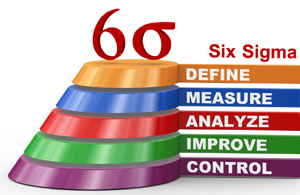
Process is the focal point of DMAIC. The methodology seeks to improve the quality of a product or service by concentrating not on the output but on the process that created the output. The idea is that concentrating on processes leads to more effective and permanent solutions.
When to Use DMAIC
DMAIC is used by a project team that is attempting to improve an existing process. DMAIC provides structure because each phase of the process contains tasks and tools that will lead the team to find an eventual solution. While DMAIC may be sequential, it is not strictly linear. The process encourages project teams to backtrack to previous steps if more information is needed.
The phases of DMAIC
The phases or stages of DMAIC include:
Define – The project begins by creating a team charter to identify team members, select the process the team will be improving and clearly define the objective of the project. The project team will then identify the CTQs to help measure the impact the problem has on the customer. This phase is completed when the team creates a process map that includes the process’s inputs and outputs .
Measure – This phase includes creating and executing a data collection plan that provides reliable and significant data. The data indicates how the process is performing and helps identify the villain in the Six Sigma narrative – variance. After this point, the project team’s efforts focus on eliminating or reducing variance as much as possible.
Analyze – Once process performance has been quantified, the analyze phase of DMAIC helps identify possible causes of the problems. A sub-process map can help identify the problems in the process and tools such as ANOVA and regression analysis can help narrow these problems to root causes. In this phase, the team is able to quantify the financial benefit of solving the problem.
Improve – Once the problem’s root cause is brought to light, the improve phase focuses on finding a permanent solution to the problem. This is where the project team’s creativity comes into play in finding an answer to a longstanding process problem. The team then tests a proposed solution in a pilot program to test if the solution is effective and financially viable.
Control – In this phase, the project team documents the new solution that they have created so that it can be passed on to process owners. The project team then implements the solution according to the timeline and key milestones they have developed. Once the solution has been implemented, the project team monitors it for several months and if it meets performance expectations turns it over to the process owner .
DMAIC is a systematic, objective and fact-based system of problem solving. The steps in the Six Sigma DMAIC methodology make process improvement accessible and learnable even for those who are just becoming acquainted with it.

What are the Phases of Lean Six Sigma?

Table of contents
- What are the phases of Six Sigma?
What’s DMAIC?
Why is the dmaic process important, the five phases of dmaic, 5. control, the dmaic benefits, related articles.
Six Sigma applications use the DMAIC principles model to improve the quality and efficiency of their processes. The four letters of DMAIC are the phases of Lean Six Sigma : Define, Measure, Analyze, Improve, and Control phase.
Companies have always had the goal to increase their profits and sales. These numbers, in turn, reflect product and service quality. The race to the bottom is fiercer than ever with new technologies constantly making their way into the business. Organizations are constantly looking for ways to improve their operations and make them more efficient. DMAIC is one reason why more companies are using it. It’s a core technique that acts as the foundation for 6 Sigma projects and any other process improvement project.
Proper implementation of DMAIC has been proven to be beneficial for businesses in many areas. This can reduce the cost of low quality, increasing revenue and improving overall business performance and productivity.
DMAIC is a data-driven cycle that aims to improve, optimize, and stabilize business processes and designs. Six Sigma projects are driven by the DMAIC improvement cycles.
Six Sigma DMAIC is a five-phase principles strategy that improves a variety of organizational processes. It can be used for software development, manufacturing, and other purposes. This strategy is often associated with Six Sigma but can be used to improve other processes and lean . DMAIC, a data-driven technique for problem-solving, is designed to identify inefficiencies and make improvements more predictable.
The acronym stands to denote the five phases: Define, Measure Analyze and Improve, Control, and Control. It is pronounced .
The DMAIC methodology is rooted in the PDSA (“plan. do. study. act”) cycle that Walter A. Shewhart , a statistician at Bell Laboratories, developed in the 1930s. The technique we know today was shaped by the biggest companies in the world, such as Toyota, Motorola, and GE. You can find out more about Six Sigma development and the history of DMAIC.
Before we get into the main steps, there is an additional step that many companies use to determine if DMAIC is the best approach to solving their problems. “Recognize” is the name of this step.
This step is crucial, even though it is not part of DMAIC. DMAIC can’t be applied in all cases. There are specific conditions where this technique can be the right fit for
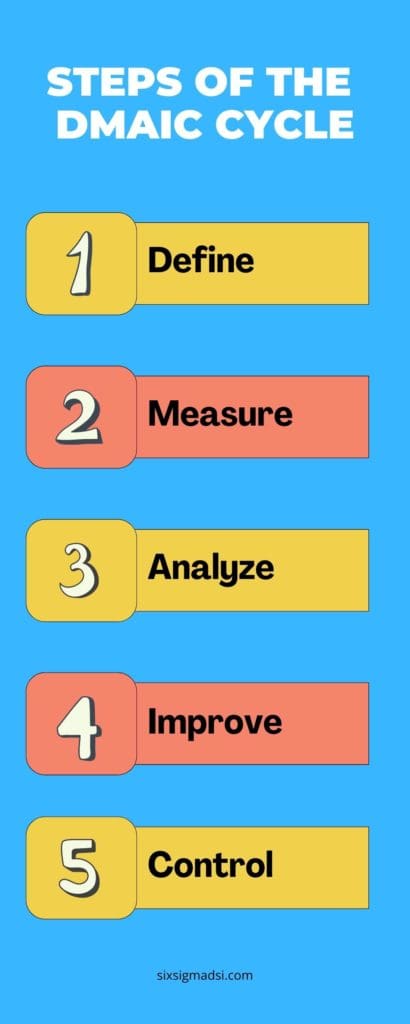
Five key phases of the DMAIC process are required to improve your process, chart goals, track progress and analyze results. These five phases, along with an explanation for each one, are:
1. Define
The Define phase in Lean Six Sigma identifies the most important and significant opportunities for improvement than the other phases. This phase also involves mapping the process, scope, focus, and ultimate goal. It also helps to understand how the problem affects all parties. To jumpstart a DMAIC process, you need to create the problem statement.
These are the other crucial steps to take at this stage:
- Recognize the high-potential opportunities for improvement
- Define the scope of your project
- To document each step of the process, create a value stream map ( VSM ).
- To pinpoint customer needs, create a voice-of-the-customer table (VOCT).
- Identify all stakeholders
- Project impact and completion estimates
- Identify and document business opportunities
- Other related processes can be drawn
The Lean Six Sigma Define principles phase is a key step in moving forward with clearly defined objectives and a timeline to complete the project phases.
2. Measure
The Measure phase allows you to draw baselines that will help you evaluate the performance of your process. It’s hard to track progress without having benchmarks. At this stage,
- To measure success, develop data collection methods
- Recognize input, process, and output indicators
- Examine and collect current state data
- Analyze the failure modes and their effects
- Analyze the capability to implement
Visual management tools like control charts, bar charts, and run charts can be very helpful. This stage can lead to better results.
3. Analyze
This phase aims to find and address the root causes of the problem.
These are the most important steps in this stage:
- A complete root cause assessment (RCA) that covers a wide range of techniques and methodologies including event analysis and the Kepner–Tregoe problem-solving and decision-making model.
- To identify potential problem areas, inefficiencies, and flaws, as well as defects and deficiencies, failure mode (FMEA), is recommended.
- A multivariate chart can be used to visualize the variations in a process.
- Controlling the process
- Develop a plan to improve
You will be able to capture and document all potential improvements and your plan for action will begin to take shape after this phase.
4. Improve
Now is the right time to make improvements.
The following activities are included in this stage:
- Think of solutions and brainstorm ideas.
- To determine the expected benefits of a solution, create a design of experiments .
- Revision of process maps and plans based on the data from the previous stage
- Plan and outline a test solution
- To improve the process, implement Kaizen events
- All stakeholders should be informed about the solution
This stage is where improvement management software can be very helpful. This software makes it possible to seamlessly move the process, facilitate cross-functional collaboration, and allow the executives and managers to track the progress of any DMAIC project.

Once you have made the necessary changes and addressed the issues to improve your operations, it is time to control the process to ensure its continued effectiveness.
Here’s where you should be:
- Document the new work standard.
- Create a quality assurance plan to ensure that everyone is using the same techniques and metrics
- Reconfirm the reduction of failures attributable to the targeted cause
- To monitor the process execution and to identify potential issues, use statistical control (SPC).
- If necessary, make additional improvements to achieve process goals
- Process improvements can be made more efficiently with the ” FiveS’s” Lean
- The document, integrate, and communicate lessons learned
You can calculate the total impact of process changes on cost, efficiency, quality improvements, productivity, customer satisfaction, and customer satisfaction after the Control phase.
The DMAIC cycle continues on until there are new opportunities to improve. It takes time, effort, and discipline to start a DMAIC process. But once your team is comfortable with it, they will be able to adapt.
It is important that your company has a clear plan for achieving your goals when trying to improve a process. The Six Sigma DMAIC process’s main principle and advantage is its structure, but simple approach. Organizations will struggle to track what is working and how it’s changing or eliminate any that aren’t. Even the most successful process changes will not be implemented if there are no effective controls.
This approach requires extensive documentation and is structured. It allows businesses to improve their problem-solving skills and increase productivity. The data gathered can be used to support other projects in the same company, providing better baselines.
Have you used the DMAIC phases for any of your projects?
Let us know in the comments below.
- Everything you need to know about a Green Belt certification
- What is a Six Sigma Black Belt Project?
- DMAIC: What is it? What does it mean?
- Six Sigma Analyze Tollgate Review (Plus Free Template)
Submit a Comment Cancel reply
Your email address will not be published. Required fields are marked *

Popular Articles:
- What is LEAN?
- What Is Six Sigma?
- What is a Green Belt?
- What is a Black Belt?
- What is a Yellow Belt?
- What is a White Belt?
- What is an FMEA?
- What is a Value Stream Map?
Insert/edit link
Enter the destination URL
Or link to existing content

- 0887 687 617
- [email protected]
Articles I Meet the Expert - InterQuality

THE LEAN SIX SIGMA METHOD: FIVE PHASES FOR PROCESS IMPROVEMENT
How to save ourselves from process problems and make a saving from process problems, lean six sigma: practical application.
One of the most widely spread and proven process improvement approaches is the combination of Lean and Six Sigma methods. Both Lean and Six Sigma are methods for quality improvement that have been applied to service and production processes all around the world already for decades. The roadmap for improvement through the application of these methods follows a structured approach and implementation logic, so that we achieve the desired results. There are multiple benefits of applying Lean Six Sigma in any organisation – from solving complex process problems to building a continuous improvement organisational culture in the long run. In addition, specific benefits of solving process problems are related to decreasing costs, mininizing number of defects and errors, better alignment between teams, more satisfied customers, and from there – increased sales and more revenue.
INTRODUCTION: STRUCTURED APPROACH TO PROBLEM SOLVING
LEAN METHOD
The roots of Lean lie in the Toyota Production System. Minimizing wastes and improving the process flow are the heart of Lean. The objective of Lean Methodology is to reduce wastes so that we add more value for the customer – this is done by minimizing or eliminating the process steps that do not add value.
We do this by:
Eliminating the wastes that block the flow of the process Using pull system that facilitates the process elements to move smoothly through the process
SIX SIGMA METHOD
Six Sigma method originated in Motorola in 1980s. It is a process improvement approach based on data analysis and aiming at increasing levels of quality. The main metric is sigma level or the so called defects per million opportunities (DPMO - defects per million opportunities). Achieving six sigma level of process performance means that the process has 3.4 defects per million. The Six Sigma method determines to what extent a particular characteristic (of a product or service) achieves customer specifications. The focus is on defects prevention and having controls in place that help prevention, rather that on defects detection.
COMBINED LEAN SIX SIGMA METHOD
Lean and Six Sigma methods both being process improvement methods, work exceptionally well in combination and provide a great opportunity to effectively resolve complex process problems. The Lean Six Sigma combination uses the Lean strength for optimizing and smoothing the process flow, i.e. increasing process speed. Six Sigma provides better precision and accuracy. This combination of Lean Six Sigma is a globally recognised approach for successfully improving processes.
THE FIVE-PHASE ROADMAP FOR PROCESS IMPROVEMENT
The application of the Lean Six Sigma approach is done systematically and following the logic and rules of the roadmap, i.e. the five phases for improvement (DMAIC). The five phases are: Define, Measure, Analyse, Improve and Control. These five phases are used for setting up and running improvement projects that are implemented for solving process problems.
SELECTING THE RIGHT PROJECTS
Lean Six Sigma is a method for solving process issues – we need a process that is not working well and that we wish to improve, as well as a problem that is highly complex and can not be resolved with applying traditional measures. If the solution is known, this method will not help. Its strength is in analysing the problem in depth with the objective to discover its key root causes for which we will find solutions. Before launching a process improvement project, we need to make a good selection. Here are some key requirements for project selection:
- To observe issues in the process
- To be able to process collect data and analyse it
- To have the support of key stakeholders and the topic to be a priority for the organisation
Below we will go through each of the phases of the improvement roadmap.
PHASE 1: DEFINE
The objective of Define is to define a problem that we wish to resolve. This is the first phase of the improvement roadmap. Defining the problem in greater detail increases the chances of finding the right solutions.
DEFINING THE PROBLEM
Coming up with a problem definition is the first step to resolving it. What does that mean? We need to start with initial investigation of the problem and collect more information about it. What is it that indicates a process problem? – customer complaints, large number of defective products, warranty losses, unhappy suppliers and partners, revenue decrease, indicators that are getting worse, etc.
As a first step, we determine process boundaries, i.e. which is the process that we wish to improve, where it starts and where it finishes. In which part of the process we notice issues? What indicates a problem exactly in these process steps? What losses does this bring as a result, i.e. how severe is the issue for the organisation, what departments are affected? What would be the benefits of solving it? This initial assessment provides a solid starting position for the upcoming project phases where this analysis will be done in greater depth.
PROJECT CHARTER
The project charter includes a problem definition together with other important project information: project objectives, key process indicators and desired target levels, stakeholders, key stages and timelines, project sponsor, project team members.
PROJECT RESOURCES
For successfully implementing the project we need a team of experts that contribute with their expertise and knowledge for resolving the problem. Who are the people closest to the problem? How many and which teams and departments are affected? Who are the employees most interested in solving the issue? Who is the leader that can be at the forefront of driving the change and become a project sponsor? We need a qualified project lead (yellow belt, green belt or black belt), who has the knowledge and experience to skilfully handle Lean Six Sigma methodology. It is important to have experts assigned to the project who can practically contribute to it and are willing to do so, and who also recognize the need for change. It is a good practice that the core team is made of 5 – 6 key experts, so that we achieve focused discussions and effective time management for meetings. One of the tasks of the project lead is to ensure that the project team will be able to spend sufficient time on project work and confirm this commitment with the respective managers.
PROCESS MAPPING
A key tool to understand the process is process mapping. This is a tool that visualizes the process elements, helps understand the flow, the link and sequence of process steps, as well as the interaction between the different functions. There are a few process mapping techniques that can be used. One is the so called process flowchart with detailed process steps. Another tool that is recommended to be used is the SIPOC diagram, listing the major process steps on a high level, the inputs and outputs at process step level, as well as the functions at each process step. Building this picture of the process as it currently works, helps build the image of the initial process baseline.
VOICE OF THE CUSTOMER
Customer stands at the heart of process improvements – with his specific needs and requirements. We define ‘customer’ as the beneficiary of the product or services at the end of the process. Customers can be ‘internal’ or ‘external’ to the organisation. During Define phase the team looks for feedback from the customer with the purpose to clarify customer needs, and from there – to define specific requirements. With the help of some tools, these requirements are translated into specific indicators and suggestions that are then included in the project scope.
PHASE 2: MEASURE
Measure phase is an opportunity to learn more about how the process currently works by collecting and analysing process data that gives us more information about this.
HOW THE PROCESS CURRENTLY WORKS
By understanding how the process currently works, we mark the starting point of measuring the process. We collect data on a few key indicators identified during Define phase. The purpose is to track how these indicators change over time, and at the end of the project to compare the status before and after the change; by noticing change in these key indicators we check to what extent we have managed to improve the process. The Lean Six Sigma method is based on data analysis and evidence based on data, and Measure phase marks the beginning of collecting and analyising data.
WHERE TO COLLECT DATA
During the first phase of Define we complete the initial analysis of the problem and the process steps where this problem occurs. Based on these, we take process measurements not only on the overall work of the process (e.g. number of defects at the end of the process, total lead time, etc.), but also on specific process steps for which we have an indication for occurring issues. In this way we perform focused measurements on problematic steps that will be analysed in the next DMAIC phase.
DATA COLLECTION PLAN
To be able to complete Measure phase we need data. One key requirement before starting the project is to ensure we have process data available. For some indicators we may need to initiate additional data collection during the course of the project. The data collection plan states a few critical aspects: for which indicators we collect data, how the data is to be collected (system source or manually), types of data, who is responsible for data collection, how the data is to be analysed and for what purpose.
DATA QUALITY CHECK
In order to achieve reliable analysis results, the data we collect must meet a few key criteria: to be collected according to a clear definition and method, to be collected at regular intervals, measurement method to be clearly stated and observed, etc. The method for checking data quality is part of the Lean Six Sigma trainings where it is studied in greater detail.
PHASE 3: ANALYZE
The main objective of Analyse phase is to uncover the problems and from there – to analyze and confirm possible root causes. By treating the root causes the team is working on preventing their re-occurence with the purpose of systematic and long term resolution.
STUDYING THE PROCESS
At the start of the project we perform research of issues. In Analyse phase this research goes deeper aiming for a more holistic view on the problem analysis. Additional information, data, feedback are collected from clients and stekeholders.
ISSUES CLASSIFICATION
The logical classification of issues is an important step to their resolution. We determine clusters according to key characteristics. One of the tools that we use is the so called Affinity diagram.
ROOT-CAUSE ANALYSIS
Root-cause analysis dates back to Toyota Production System and is one of the oldest and most successful analysis tools. The Ishikawa diagram, also known as Fishbone, provides an opportunity to reach to the essence of any problem and discover its root causes. Engaging the right experst and skilfully facilitating the discussion are of critical importance for successfully applying this tool. In the Lean Six Sigma trainings participants receive detailed guidance on the tool usage and also practise in learning environment.
PRIORITISATION AND CONFIRMATION OF ROOT CAUSES
The next step is prioritizing the root causes in line with the project objectives, assessing their impact on problem resolution, as well as searching for data evidence that these are the real root causes for the problem to appear. At this stage we look for evidence through data analysis, testing hypothesis, possible correlations and other analysis tools from the wide range of Six Sigma methods.
PHASE 4: IMPROVE
Improve Phase is the stage of finding feasible solutions and their implementation. From addressing the confirmed root causes the team generates solutions that remove process problems in the long term.
SOLUTIONS THAT ADDRESS ROOT CAUSES
Based on confirmed root causes the team starts work on identifying feasible solutions. Creative thinking techniques are used together with practising group facilitation and using decision making tools. Improve phase is when feasible solutions are found and implemented. From addressing the confirmed root causes the team generates solutions that remove process problems in the long term.
SOLUTION SELECTION
The proposed solutions are further analysed and a prioritization and selection of the best ones is made focusing on those that will have highest positive impact. Key criteria are selected and the solutions are prioritized using relevant prioritization tools.
SOLUTION IMPLEMENTATION
Implementation plan for solution realization is completed. The plan contains a detailed list of activities, deadlines, owners, etc. In addition, there is traking of how key indicators change over time and monitoring is established for possible issues.
REPORTING INITIAL RESULTS FROM SOLUTION IMPLEMENTATION
After completing the implementation the team reports the first set of results. This gives us an initial indication about the operation of the new process shortly after the change. We can compare the baseline data at the start of the project with the data right after the solution implementation.
PHASE 5: CONTROL
Control phase is the final phase of the improvement project. During this phase we report the final results and stability of the improved process; we also complete activities that ensure sustainable performance after the process change.
REPORTING FINAL PROJECT RESULTS
After implementation is completed, we continue to collect and report data on key indicators that we have identified in the Project charter and for which we have collected baseline data. This is done with the purpose to track change in indicators over time and to prove through data that the process has been changed, by comparing data at the start of the project before the change to data at the end of the project and after the defined monitoring period is closed. This is the way to demonstrate that the project has resulted in a process change and this change is positive.
SETTING UP CONTROLS
Setting up controls is done with the purpose to achieve sustainability of the change over time. The suitable control levers ‘catch’ potential problems on time and prevent the occurence of new issues.
ENSURING SUSTAINABILITY
After achieving and proving positive change, we need to work towards making it sustainable over time. Apart from setting up controls, we need other mechanisms: training, updating SOP (standard operating procedures) documentation, communication, maintenance plan, control plan, etc. depending on the process. If a process is left without proper controls, it tends to go back to its initial condition after a period of time.
- LEAN METHODOLOGY
- LEAN SIX SIGMA YELLOW BELT (LSSYB)
- LEAN SIX SIGMA GREEN BELT (LSSGB)
- LEAN SIX SIGMA BLACK BELT (LSSBB)
- LEAN SIX SIGMA FOR CHAMPIONS (EXECUTIVES)
- CERTIFICATE VERIFICATION
- PROJECT MANAGEMENT (PM)
- PROFESSIONAL SCRUM MASTER (PSM I)
- PROFESSIONAL SCRUM PRODUCT OWNER™ (PSPO I)
- SCRUM DEVELOPER CERTIFIED (SDC™)
- SCRUM MASTER CERTIFIED (SMC™)
- SCRUM AGILE MASTER CERTIFIED (SAMC™)
- SCRUM PRODUCT OWNER CERTIFIED (SPOC™)
- EXPERT SCRUM MASTER (ESM™)
- IT TRAINING
- LEAN CONSULTING
- STRATEGY AND TRANSFORMATION
- DATA MANAGEMENT, ANALYTICS AND INSIGHTS
- GLOBAL BUSINESS SERVICES AND CENTER OF EXPERTISE
- WHY GET SIX SIGMA CERTIFIED?
- SIX SIGMA VERSUS TRADITIONAL QUALITY
- SCRUM CERTIFICATION HIERARCHY
- SCRUM METHODOLOGY
- SCRUM BODY OF KNOWLEDGE
- AGILE METHODOLOGY
- PROJECT MANAGEMENT
- PROCESS OPTIMISATION THROUGH LEAN METHODS
- SUPPLY CHAIN OPTIMISATION THROUGH LEAN & SIX SIGMA
- DATA ANALYTICS PROJECT
- ENGAGEMENT PROJECT
In order to provide you with the best online experience this website uses cookies.
By using our website, you agree to our use of cookies. Learn more
.css-s5s6ko{margin-right:42px;color:#F5F4F3;}@media (max-width: 1120px){.css-s5s6ko{margin-right:12px;}} Join us: Learn how to build a trusted AI strategy to support your company's intelligent transformation, featuring Forrester .css-1ixh9fn{display:inline-block;}@media (max-width: 480px){.css-1ixh9fn{display:block;margin-top:12px;}} .css-1uaoevr-heading-6{font-size:14px;line-height:24px;font-weight:500;-webkit-text-decoration:underline;text-decoration:underline;color:#F5F4F3;}.css-1uaoevr-heading-6:hover{color:#F5F4F3;} .css-ora5nu-heading-6{display:-webkit-box;display:-webkit-flex;display:-ms-flexbox;display:flex;-webkit-align-items:center;-webkit-box-align:center;-ms-flex-align:center;align-items:center;-webkit-box-pack:start;-ms-flex-pack:start;-webkit-justify-content:flex-start;justify-content:flex-start;color:#0D0E10;-webkit-transition:all 0.3s;transition:all 0.3s;position:relative;font-size:16px;line-height:28px;padding:0;font-size:14px;line-height:24px;font-weight:500;-webkit-text-decoration:underline;text-decoration:underline;color:#F5F4F3;}.css-ora5nu-heading-6:hover{border-bottom:0;color:#CD4848;}.css-ora5nu-heading-6:hover path{fill:#CD4848;}.css-ora5nu-heading-6:hover div{border-color:#CD4848;}.css-ora5nu-heading-6:hover div:before{border-left-color:#CD4848;}.css-ora5nu-heading-6:active{border-bottom:0;background-color:#EBE8E8;color:#0D0E10;}.css-ora5nu-heading-6:active path{fill:#0D0E10;}.css-ora5nu-heading-6:active div{border-color:#0D0E10;}.css-ora5nu-heading-6:active div:before{border-left-color:#0D0E10;}.css-ora5nu-heading-6:hover{color:#F5F4F3;} Register now .css-1k6cidy{width:11px;height:11px;margin-left:8px;}.css-1k6cidy path{fill:currentColor;}
- Project management |
- Six Sigma: All you need to know about t ...
Six Sigma: All you need to know about the lean methodology

Six Sigma is a process improvement method that helps organizations improve their business processes. The end goal of Six Sigma is to reduce the amount of variations in a process as much as possible in order to prevent defects within your product. While this methodology is often used to optimize manufacturing processes, it can also be applied to other industries—including tech companies who produce digital products rather than physical ones.
Imagine your development team is in the process of putting the final touches together for a big product launch. When the product gets to the testing stage, the team catches several unanticipated bugs in the code. How can your team prevent this from happening in the future?
One way to do this is to implement an old manufacturing tool: the Six Sigma methodology.
What is Six Sigma?
The main philosophy of Six Sigma is that all processes can be defined, measured, analyzed, improved, and controlled (commonly referred to as the DMAIC method).
According to Six Sigma, all processes require inputs and outputs. Inputs are the actions that your team performs, and the outputs are the effects of those actions. The main idea is that if you can control as many inputs (or actions) as possible, you also control the outputs.
Where does Six Sigma come from?
In 1809 , German mathematician Carl Friedrich Gauss first used the famous bell curve to explain measurement errors. In the 1920s , Walter Shewhart found that three sigma from the mean is the precise point where a process needs to be corrected.
But it wasn’t until 1986 that the engineer and developer Bill Smith created the Six Sigma methodology for Motorola that we know today. Motorola used the methodology to identify the maturity of a process by its “sigma” rating, which indicates the percentage of products that are defect-free.
By definition, a Six Sigma process is one in which fewer than 3.4 defects per million opportunities occur. In other words, 99.9997% of opportunities are statistically expected to be free of defects.
Six Sigma is still commonly used in lean manufacturing and production because the process can be helpful in preventing and eliminating defects. However, this methodology can also be used in the service industry and with software engineering teams.
Lean Six Sigma
In general, the goal of a lean methodology is to drive out waste or anything that doesn’t add value to a product or process. The Lean Six Sigma (LSS) methodology values defect prevention over defect detection. This means that the goal of LSS is not to identify where the defect is, but to prevent defects from happening in the first place.
The 5 key principles of Six Sigma
The Six Sigma methodology has five key principles you can use when analyzing your processes.
1. Focus on the customer
In Six Sigma, the goal is to ensure you can provide your customers with as much value as possible. This means your team should spend a lot of time identifying who your customers are, what their needs are, and what drives their behavior to purchase products. This principle works well for SaaS companies since they often focus on recurring revenue streams.
Identifying your customer’s wants and needs can help your team better understand how to retain customers and keep them coming back to your product.
This requires your team to understand the quality of product your customers would find acceptable, so you can meet or even exceed their expectations. Once you understand that level of quality, you can use it as a benchmark for production.
2. Use data to find where variation occurs
Outline all of the steps of your current production process. Once you’ve done this, analyze and gather data on the current process to see if there are certain areas that can be optimized or areas that are causing a bottleneck in your workflow.
For example, consider how you share information with your team. Is everyone on your team getting the same information, or are they referencing outdated documents? Establishing a centralized location for all pertinent project information can help minimize the amount of time spent searching for the right documents.
Sometimes it can be challenging to decide what metrics you need to analyze. An easy way to figure this out is by working backward. Identify a goal you want to achieve and work back from there. For example, if your goal is to shorten production time, analyze how long each step in the production process takes.
3. Continuously improve your process
While you’re looking at your production process, consider any steps that don’t add value for your team or your end customers. Use tools such as value stream mapping to identify where you can streamline processes and decrease the amount of bottlenecks.
The idea of making small improvements to your processes over time is known as kaizen , or continuous improvement. The philosophy behind continuous improvement is that if you’re making small changes over a long period of time, it can lead to major positive changes in the long run.
4. Get everyone involved
Six Sigma is a methodology that allows everyone on the team to contribute. However, this does require everyone on the team to have some training on the Six Sigma process to reduce the risk of creating more blockers instead of getting rid of them.
Six Sigma works especially well when cross-functional teams are involved, because it provides a holistic view of how a process can affect all parts of your business. When you include representatives from all teams involved in a process, you give everyone insight into the improvements you’re making and how those changes might impact their teams.
We’ll dive into the different types of Six Sigma trainings and certifications later in this article.
5. Ensure a flexible and responsive ecosystem
Six Sigma is all about creating positive change for your customers. This means you should consistently look for ways to improve your processes, and your entire team should stay flexible so they can pivot without much disturbance.
This also means that processes need to be easily interchangeable. An easy way to do this is to break out processes into steps. If there’s an issue with just one step, then only that step needs to be fixed, as opposed to the entire process.
The two main Six Sigma methodologies
There are two common processes within Six Sigma and they’re each used in different situations.
In general, the DMAIC method is the standard method to optimize existing processes. Alternatively, use the DMADV method when a process is not yet established and you need to create one.
DMAIC is an acronym, meaning each letter represents a step in the process. DMAIC stands for define, measure, analyze, improve, and control.
![the six sigma problem solving approach contains the phases of [inline illustration] The DMAIC method (infographic)](https://assets.asana.biz/transform/46927ad3-2209-4e07-b611-1163af089e1a/inline-project-management-six-sigma-1-2x?io=transform:fill,width:2560&format=webp)
Define the system. Identify your ideal customer profile, including your customers’ wants and needs. During this stage you also want to identify the goals of your entire project as a whole.
Measure key aspects of current processes. Using the goals you established in the “define” stage, benchmark your current processes and use that data to inform how you want to optimize your project.
Analyze the process. Determine any root causes of problems and identify how variations are formed.
Improve or optimize your process. Based on the analysis from the previous step, create a new future state process. This means you should create a sample of the improved process and test it in a separate environment to see how it performs.
Control the future state process. If the results in the “improve” stage are up to your team’s standards, implement this new process into your current workflow. When doing this, it’s important to try and control as many variables as possible. This is often done using statistical process control or continuous monitoring.
DMAIC example
Your product team notices that the customer churn rate (the rate at which customers stop doing business with you) is increasing. To prevent this problem from getting worse, you can use the Six Sigma DMAIC methodology to identify the issue and develop a solution.
Define: The customer churn rate has increased from 3% to 7% in the last six months.
Measure: Your team has a lot of information about how prospective customers convert into actual customers, but there’s not much information about what happens after someone becomes a customer. You decide to analyze and measure user behavior after they purchase the product.
Analyze: After looking at the behavior of users after they become customers, your team notices that newer customers are having a harder time getting used to the new product UI than existing customers.
Improve: Your team decides to implement a “new customer onboarding” workflow that helps customers identify key parts of the product and how to use it. Your team works with the customer success team to help set best practices and create trainings. This gives the customer success team all the information they need to train new customers effectively and ensure customer satisfaction.
Control: Your team monitors both the churn rate and how customers are behaving now that the changes have been implemented. After a few months, you notice the churn rate beginning to decrease again, so you choose to keep the new changes to the process.
The DMADV method is sometimes referred to as Design for Six Sigma (DFSS). DMADV stands for define, measure, analyze, design, and verify. Here’s what to do during each phase:
Define your goals. When defining goals for the new process you’re establishing, it’s important to consider both business goals and the goals of your ideal customer profile.
Measure and identify CTQs. CTQ stands for “critical to quality.” These are the characteristics that define your perfect product. During this step you will identify how your new process can help achieve these CTQs and any potential risks that could impact quality.
Analyze to develop and design multiple options. When you’re designing a new production process, it’s important to have multiple options. Take a look at the different options you create and analyze the strengths and weaknesses of each one.
Design the chosen option. Based on the analysis in the previous step, take the next step and implement the option that best fits your needs.
Verify the design and set up pilot runs. Once you finish implementing your process, it’s time to hand it over to process owners and measure how the process works. Once the process is up and running, then your team can optimize it using the DMAIC method.
Six Sigma certification
Six Sigma is a multi-level training program . Much like in martial arts, each ranking is a different belt color that indicates a different body of knowledge and years of experience. The Six Sigma certification program breaks down into six different rankings—from white belt to champion:
![the six sigma problem solving approach contains the phases of [inline illustration] Six Sigma levels (infographic)](https://assets.asana.biz/transform/e56e51a4-a69f-4b67-bfa4-ae5f4fefc7fb/inline-project-management-six-sigma-2-2x?io=transform:fill,width:2560&format=webp)
White Belt : If you’re brand-new to the Six Sigma method, you’ll start out in this stage. Someone with a Six Sigma White Belt doesn’t need to have any formal training or certification in Six Sigma, but they understand the basic framework and guidelines. This means they can participate in waste reduction and quality control projects.
Yellow Belt : This level requires some formal training and you can receive an official Six Sigma Yellow Belt certification. With a Yellow Belt you can help contribute to strategy more than you could with a White Belt. You can now assist higher-ups with problem solving and analysis.
Green Belt : With a Six Sigma Green Belt certification, you can start strategizing and implementing smaller process improvement techniques on your own.
Black Belt : Once you receive the Black Belt certification, you will be able to break down processes and handle more complex projects than any previous belts. In this training, you’re taught how to manage large-scale changes that can impact a business’s bottom line.
Master Black Belt : The Six Sigma Master Black Belt is an additional course that helps you enhance your current skills by deepening your understanding of Lean Six Sigma. You’ll learn more about statistical tools and cultivate a greater appreciation for the DMAIC method.
Champion : You can become a Six Sigma Champion with a final training that is typically helpful for senior managers and executives who want to become proficient in guiding project teams and leaders through the different DMAIC phases.
While there is no unified standard for certification, the courses are designed to teach the essentials of the process and how to apply Six Sigma tools to your day-to-day work situations.
Track and improve workflows with Six Sigma
Improving your business processes ultimately helps reduce waste. As you brainstorm and analyze workflows, take time to pinpoint and address bottlenecks . Visualize each step in your production process so you can assign them to specific owners.
If you’re looking to improve your team’s workflows , it’s best to use software that helps connect your team and manage goals. Asana workflows can help you manage and automate how work is completed. Plus, you can easily alert other team members of workflow changes, make real-time adjustments, and create a single source of truth for your entire team.
Related resources

15 project management interview questions, answers, and tips

Critical path method: How to use CPM for project management

Unmanaged business goals don’t work. Here’s what does.

How Asana uses work management to drive product development
- Search Search Please fill out this field.
What Is Lean Six Sigma?
Understanding lean six sigma.
- Belt Levels
Lean Six Sigma vs. Six Sigma
- Lean Six Sigma FAQs
The Bottom Line
- Corporate Finance
Lean Six Sigma: Definition, Principles, and Benefits
:max_bytes(150000):strip_icc():format(webp)/wk_headshot_aug_2018_02__william_kenton-5bfc261446e0fb005118afc9.jpg)
Katrina Ávila Munichiello is an experienced editor, writer, fact-checker, and proofreader with more than fourteen years of experience working with print and online publications.
:max_bytes(150000):strip_icc():format(webp)/KatrinaAvilaMunichiellophoto-9d116d50f0874b61887d2d214d440889.jpg)
Investopedia / Daniel Fishel
Lean Six Sigma is a team-focused managerial approach that seeks to improve performance by eliminating resource waste and defects.
It combines Six Sigma methods and tools with the lean manufacturing/ lean enterprise philosophy. It strives to eliminate the waste of physical resources, time, effort, and talent while assuring quality in production and organizational processes.
Simply put, Lean Six Sigma teaches that any use of resources that doesn't create value for the end customer is considered a waste and should be eliminated.
Key Takeaways
- Lean Six Sigma seeks to improve employee and company performance by eliminating the waste of resources and process/product defects.
- It combines the process improvement methods of Six Sigma and lean enterprise.
- Lean Six Sigma helps to establish a clear path to achieving improvement objectives.
- The Lean strategy was established by Toyota in the 1940s and attempts to streamline operational processes, from manufacturing to transactions.
- Six Sigma originated in the 1980s and seeks to improve output quality by reducing defects.
Lean Six Sigma is a combination of Lean methodology and Six Sigma strategy. Lean methodology was established by Japanese automaker Toyota in the 1940s. Its purpose was to remove non-value-adding activities from the production process.
Six Sigma, on the other hand, was established in the 1980s by an engineer at U.S. telecommunications company Motorola who was inspired by Japan's Kaizen model. It was trademarked by the company in 1993. Its method seeks to identify and reduce defects in the production process. It also strives to streamline the variability of the production process.
Lean Six Sigma emerged in the 1990s as large U.S. manufacturers attempted to compete with Japan's better-made products. The combination strategy was introduced by Michael George and Robert Lawrence Jr. in their 2002 book Lean Six Sigma: Combining Six Sigma with Lean Speed.
Companies can arrange for Lean Six Sigma training and certification from a wide selection of organizations that specialize in the approaches of Lean Six Sigma and Six Sigma.
The Lean Six Sigma Concept
The lean concept of management focuses on the reduction and elimination of eight kinds of waste known as DOWNTIME, an acronym formed by the words defects, overproduction, waiting, non-utilized talent, transportation, inventory, motion, and extra-processing. Lean refers to any method, measure, or tool that helps in the identification and elimination of waste.
The term Six Sigma refers to tools and techniques that are used to improve manufacturing processes. The strategy attempts to identify and eliminate the causes of defects and variations in business and manufacturing processes.
Six Sigma's DMAIC phases are utilized in Lean Six Sigma. The acronym stands for define, measure, analyze, improve, and control. It refers to the data-driven five-step method for improving, optimizing, and stabilizing business and manufacturing processes.
A Lean Six Sigma approach that combines Lean strategy and Six Sigma's tools and techniques highlights processes that are prone to waste, defects, and variation and then reduces them to ensure improvement in a company's operational processes.
Lean Six Sigma Techniques
The techniques and tools used to accomplish essential goals of the Lean Six Sigma strategy include:
- Kanban : Workflow management practices, such as work visualization and limited work in progress, which maximize efficiency and promote continuous improvement.
- Kaizen : Practices that engage employees and promote a work environment that emphasizes self-development and ongoing improvement.
- Value stream mapping : Analyze places to eliminate waste and optimize process steps.
- 5S tool : Method to ensure that the workplace is efficient, productive, safe, and successful.
Lean Six Sigma Just-In-Time (JIT) training allows employees to focus resources on what customers need, when they need it, rather than building up unnecessary inventory.
Lean Six Sigma Phases
The DMAIC phases of Lean Six Sigma are Define, Measure, Analyze, Improve, and Control. They are used to identify and improve existing process problems with unknown root causes.
Define the problem from a company perspective, stakeholder perspective, and customer perspective. Figure out the quality expectations that customers have and the extent of the problem.
Examine the current process and how it contributes to the problem. Determine whether the process can meet the previously defined quality expectations of customers. Match each process step to your quality criteria. Support your measurements with actual performance data.
Examine all information gathered thus far to finalize the exact nature of the problem, its scope, and its cause.
Solve the problem and verify the improvement. Collaborate to structure a solution that eliminates both the problem and its cause. Use your data to ensure that the solution fits the issue at hand. Test the solution and derive performance data to support it.
Monitor improvement and continue to improve where possible. Finalize acceptable performance criteria. Establish a plan that can deal with variations that occur, sustain improvements, and prevent a reoccurrence of the original problem.
DMAIC works best when used to solve a problem relating to a process, quality, or waste issue in an organization.
Lean Six Sigma Belt Levels
Lean Six Sigma training uses Belts to denote Lean Six Sigma expertise. The exact specifications for each Belt may differ depending on what organization provides the certification.
Benefits of Lean Six Sigma
There are a number of established benefits to Lean Six Sigma methods for employees, customers, vendors, and the company.
By increasing the efficiency of important processes, companies can improve the work experience for employees and the customer experience for buyers. This can build loyalty inside and outside of a company.
Streamlined, simplified processes can increase control and a company's ability to capitalize on new opportunities quickly. They can also lead to more sales and revenue, lower costs, and more successful business results.
Involving employees in a group or a company-wide efficiency effort can improve their skills (e.g., analytical thinking and project management), improve their growth opportunities, and boost camaraderie. By preventing defects, companies save on the time, money, and human effort previously required to identify and eliminate them.
Lean Six Sigma and Six Sigma are two related strategies that can solve process problems. Both can help companies make noteworthy improvements in quality, efficiency, and use of time by analyzing the way their processes function. Both use the DMAIC phases/method. Both are based on creating a problem-solving workplace culture.
However, Six Sigma is focused on reducing defects and process variability to improve process output and quality to meet customer expectations. Lean Six Sigma is focused on reducing or eliminating the wasteful use of resources and defects to improve workflow and create more value for customers.
Lean Six Sigma combines aspects of Six Sigma (such as data analysis) and aspects of the Lean methodology (such as waste-eliminating tools) to improve process flow, maintain continuous improvement, and achieve business goals.
What Is the Meaning of Lean Six Sigma?
Lean Six Sigma is a process improvement strategy that seeks to eliminate inefficiencies in a company's process flow by identifying the causes of waste or redundancy and developing solutions to address them.
What Are the 5 Principles of Lean Six Sigma?
Define, measure, analyze, improve, and control are the five principles and phases of Lean Six Sigma. They're the steps practitioners take to create more efficient processes and a workplace culture that's focused on continuous improvement.
Why Is Lean Six Sigma Important?
Many consider it important for the measurable and consistent improvements in operations and business results that companies achieve using it. It also might be considered important because it combines the significant process streamlining of the Lean methodology of the 1940s with the Six Sigma data-driven approach of the 1980s.
What Is Lean Six Sigma Training?
Lean Six Sigma training instructs students in the basics of Six Sigma methodology, as well as the Six Sigma DMAIC roadmap. Students also learn how to apply the concepts in practical scenarios as they go through the courses.
How Much Does It Cost to Get Lean Six Sigma Training?
The cost of Lean Six Sigma Training varies depending on whether you take courses online, taught by a virtual instructor, or in-person, as well as the level of belt you are pursuing. A one-day White Belt training can range from $99 to $499. An eight-day Master Black Belt training costs $4975 for both in-person and live virtual training. A three- to four-day course in Lean Fundamentals ranges from $1300 to $2000 or $399 to $774 for an online training.
Lean Six Sigma is a management approach and method that endeavors to eliminate any wasteful use of resources plus defects in production processes so as to improve employee and company performance.
It draws on the Lean concept of the 1940s established by Japan's Toyota to reduce waste and the Six Sigma strategy of the 1980s established by U.S. company Motorola to reduce defects.
By combining these teachings, Lean Six Sigma puts the best of both to work to streamline efficient operations and financial outcomes for all kinds of organizations.
Six Sigma. " Lean Six Sigma Certification and Training - Overview ."
Six Sigma. " DMAIC: Approach to Continuous Improvement ."
Six Sigma. " Know How to Pick a Right Project for DMAIC ."
Six Sigma. " Six Sigma White Belt ."
Six Sigma. " Six Sigma Yellow Belt ."
Six Sigma. " Six Sigma Green Belt ."
Six Sigma. " Six Sigma Black Belt ."
Six Sigma. " Six Sigma Master Black Belt ."
Six Sigma. " White Belt Training ."
Six Sigma. " Online White Belt ."
Six Sigma. " Master Black Belt Training ."
Six Sigma. " Lean Fundamentals Online Training ."
Six Sigma. " Lean Fundamentals ."
:max_bytes(150000):strip_icc():format(webp)/six-sigma-e6a4f14ddb5b4b928a4945739be3bd37.jpg)
- Terms of Service
- Editorial Policy
- Privacy Policy
- Your Privacy Choices
- Topical Articles =>
- PMP Certification
- CAPM Certification
- Agile Training
- Corporate Training
- Project Management Tools
Home / Six Sigma / The Six Sigma Approach: A Data-Driven Approach To Problem-Solving

The Six Sigma Approach: A Data-Driven Approach To Problem-Solving
If you are a project manager or an engineer, you may have heard of the 6 Sigma approach to problem-solving by now. In online Six Sigma courses that teach the Six Sigma principles , you will learn that a data-driven approach to problem-solving , or the Six Sigma approach, is a better way to approach problems. If you have a Six Sigma Green Belt certification then you will be able to turn practical problems into practical solutions using only facts and data.
Attend our 100% Online & Self-Paced Free Six Sigma Training .

This approach does not have room for gut feel or jumping to conclusions. However, if you are reading this article, you are probably still curious about the Six Sigma approach to problem-solving.
What is the Six Sigma Approach?
Let’s see what the Six Sigma approach or thinking is. As briefly described in free Six Sigma Green Belt Certification training , this approach is abbreviated as DMAIC. The DMAIC methodology of Six Sigma states that all processes can be Defined, Measured, Analyzed, Improved and Controlled . These are the phases in this approach. Collectively, it is called as DMAIC. Every Six Sigma project goes through these five stages. In the Define phase, the problem is looked at from several perspectives to identify the scope of the problem. All possible inputs in the process that may be causing the problem are compared and the critical few are identified. These inputs are Measured and Analyzed to determine whether they are the root cause of the problem. Once the root cause has been identified, the problem can be fixed or Improved. After the process has been improved, it must be controlled to ensure that the problem has been fixed in the long-term.
Check our Six Sigma Training Video
Every output (y) is a function of one or multiple inputs (x)
Any process which has inputs (X), and delivers outputs (Y) comes under the purview of the Six Sigma approach. X may represent an input, cause or problem, and Y may represent output, effect or symptom . We can say here that controlling inputs will control outputs. Because the output Y will be generated based on the inputs X.
This Six Sigma approach is called Y=f(X) thinking. It is the mechanism of the Six Sigma. Every problematic situation has to be converted into this equation. It may look difficult but it is just a new way of looking at the problem.

Please remember that the context of relating X and Y to each other would vary from situation to situation. If X is your input, then only Y becomes your output. If X is your cause, Y will not be regarded as the output. If X is your input, Y cannot be called as an effect.
Let’s go further. The equation of Y=f(X) could involve several subordinate outputs, perhaps as leading indicators of the overall “Big Y.” For example, if TAT was identified as the Big Y, the improvement team may examine leading indicators, such as Cycle Time; Lead Time as little Ys. Each subordinate Y may flow down into its own Y= f(X) relationship wherein some of the critical variables for one also may affect another little Y. That another little variable could be your potential X or critical X.
A practical vs. a statistical problem and solution
In the Six Sigma approach, the practical problem is the problem or pain area which has been persisting on your production or shop floor. You will need to c onvert this practical problem into a statistical problem. A statistical problem is the problem that is addressed with facts and data analysis methods. Just a reminder, the measurement, and analysis of a statistical problem is completed in Measure and Analyze phase of the Six Sigma approach or DMAIC.
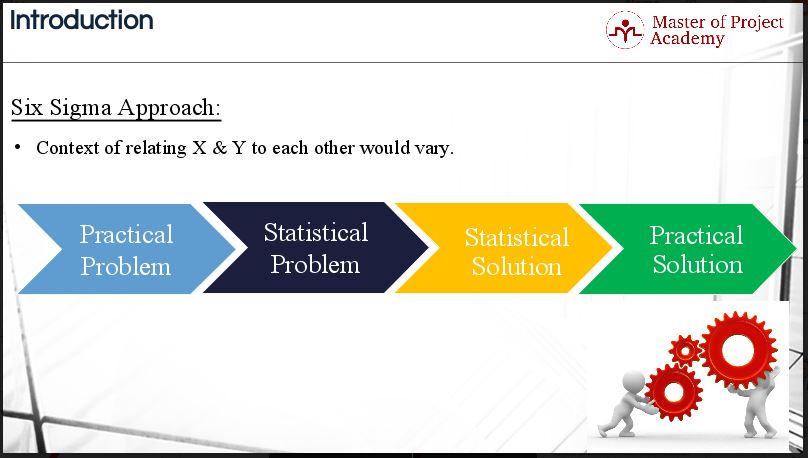
In this approach, the statistical problem will then be converted into a statistical solution. It is the solution with a known confidence or risk levels versus an “I think” solution. This solution is not based on gut feeling. It’s a completely data-driven solution because it was found using the Six Sigma approach.
A Six Sigma approach of DMAIC project would assist you to convert your Practical Problem into Statistical Problem and then your Statistical Problem into Statistical Solution. The same project would also give you the Practical Solutions that aren’t complex and too difficult to implement. That’s how the Six Sigma approach works.
This approach may seem like a lot of work. Wouldn’t it be better to guess what the problem is and work on it from there? That would certainly be easier, but consider that randomly choosing a root cause of a problem may lead to hard work that doesn’t solve the problem permanently. You may be working to create a solution that will only fix 10% of the problem while following the Six Sigma approach will help you to identify the true root cause of the problem . Using this data-driven Six Sigma approach, you will only have to go through the problem-solving process once.
The Six Sigma approach is a truly powerful problem-solving tool. By working from a practical problem to a statistical problem, a statistical solution and finally a practical solution, you will be assured that you have identified the correct root cause of the problem which affects the quality of your products. The Six Sigma approach follows a standard approach – DMAIC – that helps the problem-solver to convert the practical problem into a practical solution based on facts and data . It’s very important to note that the Six Sigma approach is not a one-man show. Problem solving should be approached as a team with subject matter experts and decicion makers involved.

Related Posts
20 thoughts on “ the six sigma approach: a data-driven approach to problem-solving ”.
- Pingback: 5 Positions Which Must Be in a Six Sigma Team - Master of Project
- Pingback: What is the Difference Between DMAIC and DMADV in Six Sigma? - Master of Project
- Pingback: 4 Benefits of Lean Six Sigma Certification - Master of Project
- Pingback: Six Sigma: What is the Normal Distribution Curve? - Master of Project
- Pingback: How Do The Six Sigma Statistics Work? - Master of Project
- Pingback: Design for Six Sigma: Why DFSS is Important? - Master of Project
- Pingback: Defects Per Unit (DPU): The Crux Of Six Sigma - Master of Project
- Pingback: First Pass Yield vs. Roll ThroughPut Yield: Why RTY is better than FPY? - Master of Project
- Pingback: Defects per Opportunity: 5 Steps to Caluculate DPO - Master of Project
- Pingback: Sigma Level : The Most Important Statistical Term in Six Sigma - Master of Project
- Pingback: Six Sigma Certification Cost: Learn the Two Main Aspects - Master of Project
- Pingback: 5 Areas of a Project Feasibility Study in Six Sigma - Master of Project
- Pingback: 7 Elements of the Six Sigma Project Charter - Master of Project
- Pingback: 5 Key Deliverables of the DMAIC Process Measure Phase - Master of Project Academy Blog
- Pingback: 2 Types of Data for Six Sigma Measure Phase - Master of Project Academy Blog
- Pingback: Six Sigma Green Belt Certification Cost - All Aspects - Master of Project Academy Blog
- Pingback: Measures of Central Tendency - Master of Project Academy Blog
- Pingback: Understanding Discrete Probability Distribution - Master of Project Academy Blog
- Pingback: Why the Binomial Distribution is Useful for Six Sigma Projects - Master of Project Academy Blog
- Pingback: Introduction to Collecting a Sample in Statistics - Master of Project Academy Blog
Comments are closed.
Disclaimer:
- PMP, PMI, PMBOK, CAPM, ACP and PDU are registered marks of the Project Management Institute.
- ITIL® is a [registered] trade mark of AXELOS Limited, used under permission of AXELOS Limited. All rights reserved.
- PRINCE2® is a [registered] trade mark of AXELOS Limited, used under permission of AXELOS Limited. All rights reserved.
- Certified ScrumMaster® (CSM) and Certified Scrum Trainer® (CST) are registered trademarks of SCRUM ALLIANCE®
- Professional Scrum Master is a registered trademark of Scrum.org
- CISA® is a Registered Trade Mark of the Information Systems Audit and Control Association (ISACA) and the IT Governance Institute.
- CISSP® is a registered mark of The International Information Systems Security Certification Consortium ((ISC)2).
Master of Project Promo Codes PMP Articles
PMP Certification Ultimate Guide – 99.6% Pass Rate CAPM Articles

Six Sigma for Students
A Problem-Solving Methodology
- © 2020
- Fatma Pakdil 0
Eastern Connecticut State University, Willimantic, USA
You can also search for this author in PubMed Google Scholar
- Gives students opportunities to practice on examples, practice, and discussion questions
- Gives students opportunities to take a role as a decision-maker in Six Sigma process
- Teaches students to apply the tools and methods of Six Sigma in each phase of the DMAIC process using a step by step approach
- Request lecturer material: sn.pub/lecturer-material
35k Accesses
3 Citations
1 Altmetric
- Table of contents
About this book
Authors and affiliations, about the author, bibliographic information.
- Publish with us
This is a preview of subscription content, log in via an institution to check access.
Access this book
- Available as EPUB and PDF
- Read on any device
- Instant download
- Own it forever
- Compact, lightweight edition
- Dispatched in 3 to 5 business days
- Free shipping worldwide - see info
Tax calculation will be finalised at checkout
Other ways to access
Licence this eBook for your library
Institutional subscriptions
Table of contents(11 chapters)
Front matter, organization of six sigma, overview of quality and six sigma.
Fatma Pakdil
Organization for Six Sigma
Cultural considerations for effective six sigma teams.
- Karen Moustafa Leonard
Define Phase: D Is for Define
Measure phase: m is for measure, measurement system analysis: gage r&r analysis, analyze phase: a is for analyze, analyze phase: other data analysis tools, control charts, improve phase: i is for improve, control phase: c is for control, back matter.
- quality management
- project management
- process improvement
- International Organization for Standardization
- organizational culture
- Gage R&R Analysis
- Improvement
“This textbook provides students with a thorough understanding of the Six Sigma approach through practical examples, utilizing a statistical perspective in problem-solving and decision-making processes.” — Dan Tenney , Board of Directors, The Child and Family Guidance Center
Book Title : Six Sigma for Students
Book Subtitle : A Problem-Solving Methodology
Authors : Fatma Pakdil
DOI : https://doi.org/10.1007/978-3-030-40709-4
Publisher : Palgrave Macmillan Cham
eBook Packages : Business and Management , Business and Management (R0)
Copyright Information : The Editor(s) (if applicable) and The Author(s), under exclusive licence to Springer Nature Switzerland AG 2020
Softcover ISBN : 978-3-030-40708-7 Published: 22 December 2020
eBook ISBN : 978-3-030-40709-4 Published: 21 December 2020
Edition Number : 1
Number of Pages : XXVII, 492
Number of Illustrations : 161 b/w illustrations
Topics : Operations Management , Management , Operations Research/Decision Theory , Business Mathematics
Policies and ethics
- Find a journal
- Track your research

Lean Six Sigma 101: A Continuous Improvement Guide
In our fast-paced, ever-evolving business landscape, companies are always looking for ways to refine their operations and boost efficiency. Lean Six Sigma stands out as a robust solution, fostering continuous improvement for these organizations.
As companies push the boundaries in pursuit of exceptional performance, Lean Six Sigma offers a powerful toolkit and guiding principles that empower organizations to tackle challenges confidently. By merging the strengths of both Lean and Six Sigma methodologies, it paves the way for organizations to reduce waste, fine-tune processes, and elevate the quality of their products and services.
What is Lean Six Sigma?
Lean Six Sigma is an integrated and comprehensive approach to enhancing operational efficiency and quality. It merges two distinct methodologies, Lean and Six Sigma, to form an effective framework for continuous improvement.
Lean originates from the Toyota Production System and focuses on eliminating activities that do not add value to a process i.e. waste.
On the other hand, Six Sigma is a data-centric methodology aimed at systematically minimizing process defects. The name “Six Sigma” represents an aspirational quality level, aiming for a mere 3.4 defects out of a million opportunities. Six Sigma employs a rigorous statistical approach to pinpoint and address root causes to achieve this quality level.
Organizations harness the best of both worlds by integrating Lean and Six Sigma. While Lean streamlines processes by cutting waste and enhancing flow, Six Sigma uses data analysis to detect and eradicate problems at the source. Together, they provide a well-rounded approach to continuous improvement.
Lean Six Sigma vs Kaizen: main similarities and differences
Both Lean Six Sigma and KAIZEN™️ provide valuable methodologies for tackling organizational challenges, albeit with distinct approaches. They differ in some aspects, each offering unique perspectives on problem-solving and continuous improvement.
Six Sigma heavily relies on quantitative metrics and statistical analysis to drive improvements in business processes, aiming to minimize defects and enhance quality. On the other hand, KAIZEN™️ focuses on holistic improvement throughout the organization, transcending reliance solely on numerical data associated with quality.
Despite these methodological nuances, both Six Sigma and KAIZEN™️ share a common goal: to optimize corporate efficiency and effectiveness by purging non-value-added activities. In practice, companies can adopt a blended approach, incorporating elements from both Six Sigma and Lean concepts, as well as from KAIZEN™️.
Both Lean Six Sigma and KAIZEN™️ stand out as exceptional concepts that yield significant time and cost savings, providing organizations with valuable tools to enhance their operations.
Why is Lean Six Sigma important?
The Lean Six Sigma is important for several fundamental reasons that positively impact organizations. This comprehensive approach to continuous improvement provides significant benefits that are reflected in various key areas:
Operational Efficiency Reach
The Lean Six Sigma is designed to eliminate waste, reduce inefficiencies, and optimize processes. This leads to more streamlined workflows, shorter cycle times, and a more efficient use of resources.
Quality Improvement
The Six Sigma methodology aims to reduce defects and enhance quality. This results in higher-quality products and services, reducing customer complaints, rework, and costs associated with errors.
Increased Customer Satisfaction
Lean Six Sigma enhances customer satisfaction by focusing on quality, reducing lead time, and delivering value to the customer.
Data-Driven Decision Making
Lean Six Sigma employs statistical analyses for informed decision-making. This diminishes subjectivity in business decisions, allowing organizations to identify and address the root causes of problems more effectively.
Cost Reduction
Lean Six Sigma significantly reduces operational costs by eliminating waste, rework, and defects. This directly improves profit margins and competitiveness.
Implementation of a Culture of Continuous Improvement and Innovation
Lean Six Sigma fosters a culture of continuous improvement throughout the organization. Employees are empowered to identify issues, implement solutions, and seek excellence in their daily processes. They are also encouraged to discover new ways of doing things, which can lead to innovative products, services, and processes.
Lean Six Sigma provides a structured and systematic approach to enhancing efficiency, quality, and customer satisfaction while driving a culture of continuous improvement and data-driven decision-making. Organizations that successfully implement Lean Six Sigma often gain a significant competitive advantage.
What are the Principles of Lean Six Sigma
The values of Lean Six Sigma are based on a combination of Lean and Six Sigma principles. The following are the main principles:
Focus on Customer Needs
All improvement efforts should be directed toward delivering products and services that meet or exceed customer expectations.
Waste Identification and Elimination
Tasks that do not add value from the customer’s perspective should be identified and eliminated.
Continuous Improvement
The pursuit of excellence is an ongoing process. Organizations should continuously seek ways to enhance their processes.
Decisions should be based on concrete analyses and data , not on assumptions. This approach aids in identifying root causes and assessing changes’ impact.
Employee Involvement
Employees are a valuable knowledge source on processes and challenges. Encouraging their active participation and involvement helps pinpoint improvement opportunities, and fosters shared accountability.
Process Standardization
Establishing clear and consistent standards for processes helps reduce variability and ensures product or service quality . Consistent processes also make it easier to detect anomalies.
Systematic and Structured Approach
Lean Six Sigma employs a systematic approach, such as the DMAIC methodology (Define, Measure, Analyze, Improve, and Control), to address issues and roll out improvements.
Leadership and Commitment
Organizational leadership plays a pivotal role in fostering a continuous improvement culture.
Measurable Outcomes
The success of Lean Six Sigma is gauged through tangible outcomes, such as defect reduction, efficiency/productivity enhancement, cost savings, and customer satisfaction. Routine measurement ensures that improvements have a positive impact.
These principles guide Lean Six Sigma’s successful implementation, setting organizations to achieve sustainable improvement in their operations and processes.
The Lean Six Sigma Methodology
As previously mentioned, Lean Six Sigma is a structured and systematic approach that combines Lean and Six Sigma principles to achieve operational excellence and continuous improvement in organizations. It provides a clear and directed path for problem-solving and process improvement, addressing waste elimination.
DMAIC: Define, Measure, Analyze, Improve, Control
The DMAIC process is at the heart of the Lean Six Sigma methodology. It is a five-step sequence that guides teams in problem-solving and process improvement.

Each step plays a specific role in the transformation process:
- Define : In this step, the team clearly defines the problem and establishes improvement objectives. Understanding the current situation, identifying stakeholders, and setting success criteria are essential.
- Measure : During this phase, the team collects relevant data about the process. Measurement is vital to understand current performance, identify variations, and determine the extent of existing problems.
- Analyze : The analysis stage involves delving into the data gathered in the previous step to identify root causes. Statistical tools are often employed to identify patterns and trends that might be contributing to the issue.
- Improve : By understanding the root causes, the team develops and implements solutions. These are tested and adjusted as needed before final implementation.
- Control : The final step focuses on maintaining and monitoring the improvements. Control systems are established to ensure that changes remain effective in the long run. This involves defining Key Performance Indicators (KPIs) and creating a monitoring plan.
How Lean Six Sigma is applied in real-world scenarios
Implementing Lean Six Sigma in real-world scenarios is adapted based on the organization’s specific needs and the problem at hand. Teams are established, typically with a Green or Black Belt leader who is an expert in the methodology.
Teams go through the DMAIC stages, applying specific tools and techniques at each phase. This might encompass data analysis, value stream mapping, and design of experiments, among others. The methodology is versatile enough to find applications in diverse sectors, from manufacturing to services.
Lean Six Sigma fosters a collaborative approach, engaging team members and relevant stakeholders throughout the process. The emphasis on data collection and analysis supports informed decisions, while the continuous improvement culture encourages experimentation and innovation.
Ultimately, Lean Six Sigma results in sustainable improvements in processes and quality, cost reduction, heightened customer satisfaction, and an organizational culture geared toward excellence .
What are Lean Six Sigma Tools
Lean Six Sigma boasts a wide range of tools and techniques that assist in problem identification, data analysis, problem resolution, and continuous improvement. These tools are employed throughout the DMAIC process stages to guide teams in systematically addressing issues. Here are some of the primary tools:
Value Stream Mapping
A visualization tool for a process flow, used during Value Stream Analysis , which identifies value-adding and wasteful activities. It aids in waste elimination and process optimization.
Diagrams (Fishbone or Cause and Effect Diagram)
Utilized to find an issue’s potential causes, this diagram categorizes them into areas such as people, processes, equipment, materials, and environment.
Control Charts
These are employed to monitor a process’s performance over time. They assist in identifying variations and deviations from set targets.
Pareto Analysis
A tool for prioritizing the most significant problems or causes and identifying the main contributors to a given problem.
Root Cause Analysis
Using tools such as the 5 Whys, teams delve deep into the underlying causes of a problem to identify the root cause.
Design of Experiments (DOE)
Used to test multiple process variables and reveal which factors have the most significant impact on process outputs.
Scatter Plots
These display the relationship between two variables and assist in finding a potential correlation between them.
Regression Analysis
Employed to examine the relationship between independent and dependent variables, allowing for outcome predictions based on historical data.
Failure Modes and Effects Analysis (FMEA)
Evaluates potential failure modes in a process or system, identifying their causes and impacts, and setting priorities for mitigation actions.
An approach to workplace organization and cleanliness focused on enhancing efficiency, safety, and employee motivation.
A visual workflow management tool that helps control and optimize production and material flow.
Devices or techniques designed to prevent errors and defects, minimizing the potential for human mistakes.
These are just a handful of the many tools Lean Six Sigma offers. Which tool to use depends on the problem’s nature and the project’s unique needs. By smartly combining these tools, teams can effectively pinpoint and tackle issues, achieving sustainable improvements and outcomes in organizational processes.
Lean Six Sigma Training and Certification
Appropriate training plays a pivotal role in effectively implementing Lean Six Sigma. It is essential to deeply understand the tools, techniques, and methods involved to make meaningful improvements in organizational processes and outcomes.
A Lean Six Sigma certification is a formal recognition for individuals who have shown expertise in using the methodology. This certification confirms that they have acquired the skills to lead improvement projects, apply statistical tools, and lead teams to achieve efficiency, quality, and reduce variability.
The most common certification levels – Lean Six Sigma Belts – are:
- White Belt : These are team members familiar with the basic concepts of Six Sigma and can support projects but do not hold a leadership role.
- Yellow Belt : They possess slightly advanced knowledge and can actively participate in projects as team members.
- Green Belt : These members have a deeper understanding of the Six Sigma tools and techniques and can lead small projects and collaborate closely with the Black Belts.
- Black Belt : These are highly trained and qualified project leaders. They are experts in Six Sigma and have the ability to lead complex improvement projects, apply advanced statistical tools, analyze data, and implement significant changes in processes.
- Master Black Belt : These seasoned experts lead in implementing and developing Six Sigma within the organization. They provide training, guidance, and support to Black Belts and Green Belts, ensuring the methodology is effectively applied throughout the organization.
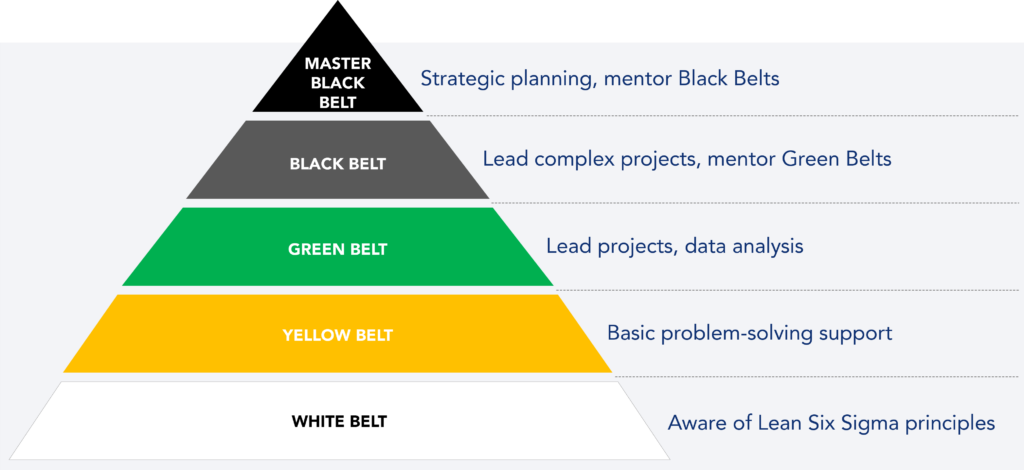
Obtaining a certification in Lean Six Sigma typically involves completing formal training, knowledge examinations, and practical application of the skills learned.
The importance of training and certification in Lean Six Sigma
Lean Six Sigma training provides detailed knowledge of its underlying tools, methodologies, and principles. It empowers professionals to effectively identify problems, analyze data, and implement solutions, leading to measurable improvements.
Certification indicates that its holder possesses the necessary skills to apply Lean Six Sigma effectively. This ensures the right approaches are adopted to address complex issues and enhance processes.
On the other hand, Lean Six Sigma-certified professionals can spread a continuous improvement culture within their organizations. They can lead teams, foster collaboration, and guide implementing improvement initiatives.
How Kaizen Institute can help you become a Lean Six Sigma expert
The Kaizen Institute offers training programs with various certification levels to meet clients’ needs. Here are some benefits of the Kaizen Institute’s training and certifications:
- Specialized Training and Belt Certification: The Kaizen Institute provides hands-on training and certification at various levels. These programs cover all aspects of Lean Six Sigma, from basic concepts to advanced techniques.
- Globally Recognized Certification: The certifications provided by the Kaizen Institute are widely recognized internationally. Earning a Lean Six Sigma “belt” validates skills and knowledge, enhancing credibility as an expert in the field.
- Practical Experience: Beyond theory, the Kaizen Institute’s courses include hands-on exercises and real-world case studies. This allows participants to apply theoretical knowledge in actual scenarios and gain confidence in their abilities.
- Continuous Learning : The Kaizen Institute offers an ongoing learning journey, allowing professionals to deepen their knowledge in Lean Six Sigma as they advance in their careers.
Still have questions about Lean Six Sigma?
What is the fishbone diagram in six sigma.
The fishbone diagram, also known as the “Ishikawa Diagram” or “Cause and Effect Diagram”, is a visual tool used within Six Sigma to identify and analyze potential causes of a specific problem. It is called the “fishbone” due to its appearance, which resembles a fish’s spine when drawn.
The basic structure of the fishbone diagram consists of a central line from which several diagonal lines branch out, each representing a potential cause category. These categories typically fit into the renowned “6 Ms”:
- Methods : Processes, procedures, policies.
- Manpower : Skills, training, workforce.
- Machines : Equipment, tools, technology.
- Materials : Raw materials, supplies, inputs.
- Measurement : Data collection methods, evaluation.
- Environment : Conditions, context, workplace setting.
Each category is further divided into specific potential causes related to the problem.
What is the meaning of Kaizen?
“KAIZEN™️” is a Japanese word that means “continuous improvement.” Within the context of Lean Six Sigma and continuous improvement, the term “KAIZEN™️” describes a systematic and ongoing approach to enhancement and problem-solving in every aspect of an organization, from processes and products to culture.
See more on Lean
Find out more about improving this business area
Get the latest news about Kaizen Institute
We noticed you're visiting from United States (US). We've updated our prices to United States (US) dollar for your shopping convenience. Use Euro instead. Dismiss

IMAGES
VIDEO
COMMENTS
DMAIC is the problem-solving approach that drives Lean Six Sigma. It's a five-phase method—Define, Measure, Analyze, Improve and Control—for improving existing process problems with unknown causes. DMAIC is based on the Scientific Method and it's pronounced "duh-may-ik.". Originally published on August 24th, 2017, this article was ...
DMAIC stands for Define, Measure, Analyze, Improve, and Control. It is a structured problem-solving methodology commonly used in Six Sigma and process improvement initiatives. DMAIC provides a systematic approach for identifying and addressing problems, improving processes, and achieving measurable results.
Statistical data analysis. Design of experiments. Hypothesis testing. Lean Six Sigma focuses on reductions in waste using processes such as: Kaizen. Workplace organization. Visual controls. In most cases, organizations today incorporate both methodologies into their Six Sigma quality management practices.
DMAIC is an acronym that stands for Define, Measure, Analyze, Improve, and Control. It represents the five phases that make up the process: Define the problem, improvement activity, opportunity for improvement, the project goals, and customer (internal and external) requirements. Project charter to define the focus, scope, direction, and ...
Lean Six Sigma brings together principles from lean manufacturing and Six Sigma. Lean manufacturing is a philosophy that emphasizes the elimination of waste and the improvement of production flow through collaborative team effort. Six Sigma is a data-driven methodology that uses statistical analysis and problem-solving tools to identify and eliminate defects as well as process variations.
The DMAIC Problem Solving Approach is a process improvement methodology based on the Six Sigma approach that helps to improve business processes and products. It is used to identify, analyze, and solve existing processes that are inefficient or ineffective. The approach breaks down into five phases: Define, Measure, Analyze, Improve and Control.
Step 3: Analyze the Problem. The analyze phase of the DMAIC process is about identifying the root cause that is causing the problem. • Referring to the process maps and value stream maps you have created, further, analyze the process to identify the problem areas. • Visualize the data you have collected (both in the 'Measure' phase and ...
Lean Six Sigma & the checklist. If problem-solving is a must-have skill and checklists are key to good outcomes, then combining the two makes sense. DMAIC - Define, Measure, Analyze, Improve & Control - is the 5-Step model for Lean Six Sigma and there's a set of required tollgates at the end of each phase. These tollgates outline what has ...
Here are the steps in the DMAIC process: Define phase: Understand what process is to be improved and set a goal. Measure phase: Measure the current state. Analyze phase: a) Develop cause-and-effect theories of what may be causing the problem; b) Search for the real causes of the problem and scientifically prove the cause-and-effect linkage.
The Define phase is approximately 2 to 3 weeks based on the project inputs and begins with selecting the project champion. The define phase is all about establishing the project, and there are many individual activities to complete. Multiple tools and concepts are available in the Define phase of Six Sigma.
DMAIC is a systematic, objective and fact-based system of problem solving. The steps in the Six Sigma DMAIC methodology make process improvement accessible and learnable even for those who are just becoming acquainted with it. If Six Sigma quality improvement methodology had to be summarized in one word, it would be the acronym DMAIC (define ...
Six Sigma emerged at Motorola in the 1980s as a statistical approach to quality management. Driven by the goal of minimizing defects and reducing process variation, Six Sigma utilizes data analysis, problem-solving methodologies, and rigorous measurement techniques to identify and eliminate root causes of errors.
3. Analyze. This phase aims to find and address the root causes of the problem. These are the most important steps in this stage: A complete root cause assessment (RCA) that covers a wide range of techniques and methodologies including event analysis and the Kepner-Tregoe problem-solving and decision-making model.; To identify potential problem areas, inefficiencies, and flaws, as well as ...
The Six-Sigma problem solving approach contains the phases of: a. detect, measure, analyze, improve, and control. b. define, measure, analyze, implement, and control. ... The _____ phase requires an understanding of the causal relationships between process performance and customer value. a. define b. measure c. analyze d. improve.
Abstract. Six Sigma is a problem-solving technique that leverages DMAIC phases (Define, Measure, Analyze, Improve, and Control) using a data-centric approach, leveraging applied statistics. It seeks to solve novel problems where there isn't an apparent root cause, or a solution identified, and helps to overcome biases and the temptation to ...
This combination of Lean Six Sigma is a globally recognised approach for successfully improving processes. The application of the Lean Six Sigma approach is done systematically and following the logic and rules of the roadmap, i.e. the five phases for improvement (DMAIC). The five phases are: Define, Measure, Analyse, Improve and Control.
Six Sigma is a process improvement method that helps organizations improve their business processes. The end goal of Six Sigma is to reduce the amount of variations in a process as much as possible in order to prevent defects within your product. While this methodology is often used to optimize manufacturing processes, it can also be applied to ...
Lean Six Sigma is a managerial approach that combines Six Sigma methods and tools and the lean manufacturing/lean enterprise philosophy, striving to eliminate waste of physical resources, time ...
Because the output Y will be generated based on the inputs X. This Six Sigma approach is called Y=f (X) thinking. It is the mechanism of the Six Sigma. Every problematic situation has to be converted into this equation. It may look difficult but it is just a new way of looking at the problem.
This textbook covers the fundamental mechanisms of the Six Sigma philosophy, while showing how this approach is used in solving problems that affect the variability and quality of processes and outcomes in business settings. Further, it teaches readers how to integrate a statistical perspective into problem solving and decision-making processes.
As previously mentioned, Lean Six Sigma is a structured and systematic approach that combines Lean and Six Sigma principles to achieve operational excellence and continuous improvement in organizations. It provides a clear and directed path for problem-solving and process improvement, addressing waste elimination.
Six Sigma tools are defined as the problem-solving tools used to support Six Sigma and other process improvement efforts. The Six Sigma expert uses qualitative and quantitative techniques to drive process improvement. Although the tools themselves are not unique, the way they are applied and integrated as part of a system is.